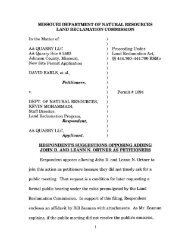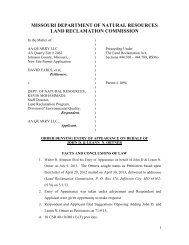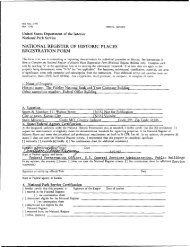Winter 2006 - Missouri Department of Natural Resources
Winter 2006 - Missouri Department of Natural Resources
Winter 2006 - Missouri Department of Natural Resources
Create successful ePaper yourself
Turn your PDF publications into a flip-book with our unique Google optimized e-Paper software.
MISSOURI<br />
resources<br />
<strong>Winter</strong> <strong>2006</strong> • Volume 23 • Number 1
Water is one <strong>of</strong> <strong>Missouri</strong>’s most<br />
treasured and vital resources.<br />
There is no aspect <strong>of</strong> our state’s future<br />
that does not depend on water in some<br />
way. As most <strong>of</strong> you know, the <strong>Missouri</strong><br />
<strong>Department</strong> <strong>of</strong> <strong>Natural</strong> <strong>Resources</strong><br />
is charged with protecting<br />
<strong>Missouri</strong>’s water quality. However,<br />
just as important is the department’s<br />
responsibility to ensure that the citizens<br />
<strong>of</strong> the state have an ample supply<br />
<strong>of</strong> water for present and future uses.<br />
Since <strong>Missouri</strong> shares the waters <strong>of</strong><br />
its major rivers with several other<br />
states, we must actively defend our<br />
state’s rights to use these waters.<br />
In this issue you will find an article<br />
about the department’s efforts to represent<br />
<strong>Missouri</strong>’s diverse interests on<br />
the <strong>Missouri</strong> River. Western states are<br />
very aggressive in the pursuit <strong>of</strong> securing<br />
more water for use in their<br />
states, <strong>of</strong>ten at the expense <strong>of</strong> downstream<br />
states. To western states, water<br />
is a transportable commodity to be<br />
bought and sold. Like it or not, we are<br />
in a battle with them for water. While<br />
<strong>Missouri</strong> has actively defended its use<br />
<strong>of</strong> the <strong>Missouri</strong> River, we continue to<br />
see less water in the river for downstream<br />
uses.<br />
To better understand the conflict, it<br />
is important to understand the two<br />
types <strong>of</strong> water law that govern water<br />
use. With the exception <strong>of</strong> Iowa and<br />
<strong>Missouri</strong>, the states along the <strong>Missouri</strong><br />
River adhere to western water<br />
law (the law <strong>of</strong> prior appropriation).<br />
Under this type <strong>of</strong> law, the state allocates<br />
the quantity <strong>of</strong> water that can be<br />
used by individuals or entities.<br />
The State <strong>of</strong> <strong>Missouri</strong> does not allocate<br />
or regulate water use. <strong>Missouri</strong><br />
subscribes to the doctrine <strong>of</strong> riparian<br />
water law in which individuals have<br />
the right to reasonable use <strong>of</strong> water.<br />
Water is a shared resource under riparian<br />
law and conflicts between<br />
users are <strong>of</strong>ten resolved in court.<br />
Both <strong>of</strong> these approaches to water<br />
rights have their strengths and weaknesses.<br />
Western states are very efficient<br />
at allocating water because they<br />
have tremendous knowledge <strong>of</strong> their<br />
water supply. However, western water<br />
law lacks a provision<br />
for reasonable<br />
or best<br />
use <strong>of</strong> water.<br />
The western<br />
system, based<br />
on prior appropriations,dictates<br />
“first in<br />
time, first in<br />
right.” In contrast, one <strong>of</strong> the<br />
strengths <strong>of</strong> the riparian system is that<br />
it takes into account the most reasonable<br />
or best use <strong>of</strong> water as a resource.<br />
A downside to the riparian<br />
system is that individual rights to use<br />
water are not clearly defined and unwise<br />
and inefficient use <strong>of</strong> the water<br />
resource can cause water shortages,<br />
especially in times <strong>of</strong> drought.<br />
With the possibility that future<br />
water battles could be decided in federal<br />
court through some form <strong>of</strong> apportionment,<br />
<strong>Missouri</strong> must improve<br />
its knowledge base <strong>of</strong> information regarding<br />
water supply, water use, and<br />
future needs to support our claims.<br />
To ensure the best use <strong>of</strong> <strong>Missouri</strong>’s<br />
water resources and to protect the resource<br />
to meet growing demands,<br />
steps must be taken to better assess<br />
the resources and develop long-range<br />
plans for <strong>Missouri</strong>’s water resources.<br />
This information will be vitally important<br />
as we defend the rights <strong>of</strong> our citizens<br />
in the future interstate water<br />
conflicts. In order to improve the<br />
state’s position to address these major<br />
challenges, I have established the<br />
<strong>Missouri</strong> Water <strong>Resources</strong> Center to<br />
help focus our efforts. Just as we have<br />
done on the <strong>Missouri</strong> River, we will<br />
strive to forge partnerships and work<br />
cooperatively in addressing our water<br />
needs. We will be an advocate and a<br />
protector for <strong>Missouri</strong>’s uses <strong>of</strong> water,<br />
both environmental and economic.<br />
Doyle Childers<br />
<strong>Missouri</strong> <strong>Department</strong> <strong>of</strong> <strong>Natural</strong> <strong>Resources</strong><br />
<strong>Winter</strong> <strong>2006</strong><br />
Volume 23 • Number 1<br />
State <strong>of</strong> <strong>Missouri</strong><br />
Governor<br />
Matt Blunt<br />
Director, <strong>Missouri</strong> <strong>Department</strong><br />
<strong>of</strong> <strong>Natural</strong> <strong>Resources</strong><br />
Doyle Childers<br />
Deputy Director, Operations<br />
Jeff Staake<br />
Deputy Director, Policy<br />
Floyd Gilzow<br />
Deputy Director, Legal<br />
Kurt Schaefer<br />
Deputy Director, Water <strong>Resources</strong><br />
Mike Wells<br />
Director, Division <strong>of</strong> State Parks<br />
Doug Eiken<br />
Director, Division <strong>of</strong> Geology<br />
and Land Survey<br />
Mimi Garstang<br />
Director, Division <strong>of</strong> Field Services<br />
Jim Macy<br />
Director, Division <strong>of</strong> Environmental Quality<br />
Dan Schuette<br />
Director, Environmental Improvement<br />
and Energy <strong>Resources</strong> Authority<br />
Tom Welch<br />
Editor<br />
Stuart Westmoreland<br />
Assistant Editor<br />
Philip J. Tremblay<br />
Editorial Board<br />
Denise Becker<br />
Kerry Cordray<br />
Kathy Deters<br />
Dawn Fredrickson<br />
Lina Klein<br />
Connie Patterson<br />
Kenneth Seeney<br />
Design Director<br />
Belinda Hughes<br />
Assistant Designer<br />
Ruby Wells<br />
Photographer<br />
Scott Myers<br />
Circulation<br />
Jeanne E. Binkley<br />
Mission Statement<br />
The mission <strong>of</strong> the <strong>Department</strong> <strong>of</strong> <strong>Natural</strong> <strong>Resources</strong><br />
is to preserve, protect, restore and enhance<br />
<strong>Missouri</strong>’s natural, cultural and energy resources and<br />
to inspire their enjoyment and responsible use for<br />
present and future generations.<br />
MISSOURI RESOURCES<br />
is published three times per year by the <strong>Missouri</strong><br />
<strong>Department</strong> <strong>of</strong> <strong>Natural</strong> <strong>Resources</strong> to inform readers<br />
about important natural resource issues and how they<br />
are being addressed. Any correspondence should be<br />
directed to the editor at the <strong>Department</strong> <strong>of</strong> <strong>Natural</strong><br />
<strong>Resources</strong>, Publications, P. O. Box 176, Jefferson City,<br />
MO 65102-0176, or call 1-800-361-4827.<br />
E-mail address: moresdnr@dnr.mo.gov<br />
MoDNR home page: www.dnr.mo.gov<br />
MISSOURI RESOURCES<br />
is available in alternative formats.<br />
As a recipient <strong>of</strong> federal funds, the <strong>Department</strong> <strong>of</strong><br />
<strong>Natural</strong> <strong>Resources</strong> cannot discriminate against anyone<br />
on the basis <strong>of</strong> race, color, national origin,<br />
religion, age, sex, or disability.<br />
If anyone believes he or she has been subjected to<br />
discrimination for any <strong>of</strong> these reasons, he or she may<br />
file a complaint with either the <strong>Department</strong> <strong>of</strong> <strong>Natural</strong><br />
<strong>Resources</strong> or the Office <strong>of</strong> Equal Opportunity, U.S.<br />
<strong>Department</strong> <strong>of</strong> the Interior, Washington, D.C., 20240.<br />
<strong>Missouri</strong> <strong>Resources</strong> is printed with soy ink on<br />
recycled paper at Banta Publications Group,<br />
Liberty, <strong>Missouri</strong>.<br />
printed on recycled paper
table <strong>of</strong> contents<br />
<strong>Missouri</strong> <strong>Department</strong> <strong>of</strong> <strong>Natural</strong> <strong>Resources</strong><br />
page 2<br />
Award-Winning Interpretation:<br />
A State Park Tradition<br />
by Gayle Mooney<br />
In 1939, only six naturalists were available to help visitors<br />
interpret and appreciate their state parks. The evolution <strong>of</strong><br />
the naturalist program reflects the public’s growing desire<br />
for knowledge. Today, <strong>Missouri</strong> state parks’ training <strong>of</strong><br />
interpretive staff is nationally recognized.<br />
page 6<br />
Heated Competition<br />
by Lindsay Tempinson<br />
Last July, students from 43 states and seven Canadian<br />
provinces competed in the annual Canon Envirothon at<br />
Southwest <strong>Missouri</strong> State in Springfield. The temperature<br />
reached triple digits, but there was no drought <strong>of</strong> enthusiasm.<br />
page 9<br />
<strong>Missouri</strong> Water … In High Demand<br />
by John Drew and Karen Rouse<br />
With 10 states and 28 American Indian tribes competing for water from<br />
the <strong>Missouri</strong> River, the interests <strong>of</strong> downstream states are constantly being<br />
challenged. The continued drought in the west and midwest has only heightened<br />
the competition between all parties.<br />
14 • News Briefs 23 • Teacher’s Notebook<br />
E-Notes, Letters, “Discover a Watershed,” A Sound Example<br />
Time Exposures, Resource Honor Roll<br />
20 • <strong>Resources</strong> to Explore 25 • One Last Word<br />
Roaring River State Park Southern Housepitality<br />
Above right: Mallori Richardson and her grandfather, Chris Ingram, came to trout fish at Roaring River State Park, near Cassville.<br />
Above: The Kansas City skyline rises above the <strong>Missouri</strong> River levee along Highway 169 in Clay County.<br />
FRONT COVER: Architecturally speaking, the new Busch Stadium will look more “historic” than its 35-year-old predecessor.<br />
BACK COVER: Aquila’s Sibley Generating Station, on the <strong>Missouri</strong> River near Kansas City, blends tires and coal to produce electric power.<br />
Cover photos by Scott Myers.<br />
DNR photos by Scott Myers
(Above) John<br />
Cunning, a natural<br />
resource manager<br />
for the Division <strong>of</strong><br />
State Parks, shows<br />
interpretive training<br />
attendees how to<br />
conduct a tour <strong>of</strong> an<br />
historic building.<br />
(Right) George E.<br />
Moore, <strong>Missouri</strong>’s<br />
first full-time chief<br />
naturalist, was a nationally<br />
known and<br />
well-respected scientist.<br />
He helped<br />
develop the first interstate<br />
naturalist<br />
training workshop<br />
in <strong>Missouri</strong>.<br />
2 <strong>Missouri</strong> <strong>Resources</strong><br />
by Gayle Mooney<br />
system has <strong>of</strong>fered various forms<br />
<strong>of</strong> training for those who interpret<br />
the state’s natural and cultural features.<br />
Doug Eiken, director <strong>of</strong> the <strong>Missouri</strong> <strong>Department</strong><br />
<strong>of</strong> <strong>Natural</strong> <strong>Resources</strong>’ Division <strong>of</strong><br />
State Parks, explained, “Without a clear understanding<br />
and appreciation <strong>of</strong> the natural<br />
and cultural resources we are charged with<br />
protecting, it would be very difficult to<br />
maintain and preserve them for future generations.<br />
The role <strong>of</strong> interpretation is to provide<br />
that understanding. That’s why training<br />
our seasonal interpretive staff is so important,”<br />
Eiken added.<br />
The <strong>Missouri</strong> <strong>Department</strong> <strong>of</strong> <strong>Natural</strong> <strong>Resources</strong>’<br />
Division <strong>of</strong> State Parks now hosts an<br />
annual 40-hour intensive training school that<br />
attracts participants from across the Midwest<br />
and South. The story <strong>of</strong> the evolution <strong>of</strong> this<br />
pr<strong>of</strong>essional training program is one <strong>of</strong> perseverance,<br />
dedication and foresight.<br />
By the late 1930s, <strong>Missouri</strong>’s state park<br />
system was just stepping into its current<br />
DNR file photo For 66 years, the <strong>Missouri</strong> state park
DNR photo by Scott Myers<br />
role <strong>of</strong> preservation and protection <strong>of</strong> the<br />
state’s natural and cultural resources. At the<br />
same time, the public’s desire to learn about<br />
outdoor life in a park setting was growing.<br />
Park naturalists would come to play a vital<br />
role in fulfilling that desire.<br />
Afew state parks had been <strong>of</strong>fering nature<br />
guide services. However, these<br />
services were unstructured and not well<br />
known to the public. In 1938, state park <strong>of</strong>ficials<br />
hired Uncas McGuire as a chief naturalist<br />
on a seasonal basis. McGuire initiated<br />
special nature programs and activities to attract<br />
the general public.<br />
In a letter dated March 2, 1939, E. A.<br />
Mayes, a state planner in charge <strong>of</strong> park operations,<br />
wrote: “A wise use and an appreciation<br />
<strong>of</strong> our state parks is absolutely essential<br />
if our department is to serve the best<br />
interests <strong>of</strong> the park areas and our people.”<br />
He indicated that because the nature programs<br />
had been so well received by the general<br />
public, there would be six seasonal naturalists<br />
hired for the 1939 season.<br />
State and national park leaders recognized<br />
the need for pr<strong>of</strong>essional training to<br />
ensure a well-rounded naturalist staff.<br />
Mayes, McGuire and other state <strong>of</strong>ficials<br />
developed a two-day training session for the<br />
1939 season. Faculty from the University <strong>of</strong><br />
<strong>Missouri</strong>-Columbia departments <strong>of</strong> anthropology,<br />
geography, entomology, geology,<br />
history, forestry and zoology agreed to participate<br />
in the training. The result was the<br />
first <strong>of</strong>ficial training session for seasonal<br />
naturalists, held on the Columbia campus,<br />
June 1 and 2, 1939.<br />
The following year, state park <strong>of</strong>ficials<br />
selected George E. Moore, regarded by<br />
some as <strong>Missouri</strong>’s most outstanding scientist<br />
<strong>of</strong> natural history, as <strong>Missouri</strong>’s first<br />
full-time chief naturalist. As chief naturalist,<br />
Moore, with his wife Polly, who was an<br />
accomplished naturalist in her own right,<br />
traveled statewide, wrote articles for major<br />
newspapers and hosted a radio program.<br />
When the National Park Service<br />
broached the idea <strong>of</strong> an interstate park naturalist<br />
conference, <strong>Missouri</strong> took the lead<br />
and, with Moore’s help, sponsored the<br />
event. Leaders from around the country met<br />
at Meramec State Park on May 11-13, 1941.<br />
The 38 participants <strong>of</strong> this nationally significant<br />
training session came from nine states,<br />
as well as the U.S. <strong>Department</strong> <strong>of</strong> the Interior.<br />
<strong>Missouri</strong> was becoming known nationally<br />
for a high level <strong>of</strong> naturalist training.<br />
In 1977, George Kastler, who began his<br />
career as a park seasonal naturalist in 1964,<br />
was hired as the system’s fifth full-time<br />
chief park naturalist, a position he holds<br />
today. Under his leadership and guidance,<br />
the number <strong>of</strong> seasonal naturalists grew and<br />
the scope <strong>of</strong> training expanded to include<br />
both cultural and natural history.<br />
“When I became the chief park naturalist,”<br />
Kastler explains, “my goal was to continue<br />
the standards that George and Polly<br />
Moore set years earlier for state park interpretation.<br />
I knew that involved increasing<br />
our seasonal staff and providing them with<br />
the best training available.”<br />
(Below) During the Kaleidoscope<br />
event, trainees learn<br />
an American Indian firestarting<br />
technique using a<br />
fire bow.<br />
(Bottom) Trainees practice<br />
using a prehistoric device,<br />
the atlatl, that allowed<br />
spears to be thrown greater<br />
distances. The atlatl and the<br />
spear were made from natural<br />
materials such as river<br />
cane, antlers and chert.<br />
<strong>Winter</strong> <strong>2006</strong> 3<br />
DNR photos by Scott Myers
By using a pump drill to<br />
place holes in freshwater<br />
mussel shells, participants<br />
learned not only an ancient<br />
technique, but also how<br />
important the shells were<br />
in jewelry making and<br />
other crafts.<br />
4 <strong>Missouri</strong> <strong>Resources</strong><br />
Seasonal naturalists come from either<br />
a scientific or historical background, from<br />
all walks <strong>of</strong> life, from college age to near<br />
retirement. Some <strong>of</strong> these seasonal employees<br />
return each summer; others are new,<br />
having been hired as a result <strong>of</strong> the many recruitment<br />
events Kastler conducts on college<br />
campuses across <strong>Missouri</strong> each spring.<br />
No matter the age or the experience, the interpreters<br />
benefit from the annual Interpreters<br />
Training School conducted before<br />
the start <strong>of</strong> each season. In addition, some<br />
<strong>of</strong> <strong>Missouri</strong>’s state historic sites routinely<br />
send their full-time and seasonal interpreters<br />
to the training school.<br />
For the past several years, a 10-person<br />
training committee <strong>of</strong> pr<strong>of</strong>essional interpreters<br />
has organized and planned each<br />
year’s curriculum. Kastler serves as chairman<br />
<strong>of</strong> the committee, composed <strong>of</strong> state<br />
parks, U.S. Army Corps <strong>of</strong> Engineers and<br />
<strong>Department</strong> <strong>of</strong> Conservation staff.<br />
MDC photo by John Miller<br />
The 40-hour training, held at Dr.<br />
Edmund A. Babler Memorial State Park in<br />
Wildwood, is broken down into basic, intermediate<br />
and advanced studies, as well as<br />
specialized coursework. The goal <strong>of</strong> the<br />
school is to teach innovative, fun and creative<br />
program ideas that turn the unknown<br />
into the understandable in a way that will<br />
fascinate and arouse the park visitor, leaving<br />
a lasting appreciation <strong>of</strong> natural and cultural<br />
topics.<br />
First-year trainees are instructed in interpretation<br />
philosophy, theme development,<br />
writing, program development, logistics<br />
and formats development.<br />
Second-year trainees have a short review <strong>of</strong><br />
these topics and receive training from a cultural<br />
perspective. Courses include caring<br />
for artifacts and living history interpretation.<br />
Third-year (or higher) trainees are certified<br />
in national programs dealing with outdoor<br />
ethics and environmental education.<br />
A fourth section was added in 2005 for<br />
anyone interested in pursuing a pr<strong>of</strong>essional<br />
career in interpretation. Participants are<br />
taught by division staff and receive certification<br />
as Pr<strong>of</strong>essional Interpretive Guides<br />
from the National Association for Interpretation,<br />
an organization dedicated to advancing<br />
interpretation as a pr<strong>of</strong>ession.<br />
In addition to classroom sessions, there<br />
are a lot <strong>of</strong> hands-on activities such as a<br />
19th century version <strong>of</strong> baseball. There are<br />
more than two dozen demonstrations showcased<br />
at the “Kaleidoscope,” a two-andone-half-hour<br />
event covering a broad range<br />
<strong>of</strong> subjects such as geology, botany, zoology,<br />
shell carving, crafts and timber framing.<br />
Stations boast names such as “Hug a Herp,”<br />
“Can I Touch It?,” “It’s a Buggy, Buggy<br />
Day,” “The Crafty Couple,” and “The Interpreters’<br />
Tapestry <strong>of</strong> Beauty.”<br />
Not all <strong>of</strong> the fun and education occurs<br />
between 8 a.m. and 5 p.m. Nighttime segments<br />
demonstrate popular park programs<br />
such as astronomy, night hikes, spider sniffs<br />
and owl prowls.<br />
All basic and intermediate-level students<br />
demonstrate the skills they have learned by<br />
presenting a short program. They also are<br />
tested on their knowledge <strong>of</strong> <strong>Missouri</strong> natural<br />
and cultural history. At the conclusion <strong>of</strong><br />
the training school, each participant receives<br />
a certificate <strong>of</strong> training. Special<br />
recognition is given to the best effort<br />
demonstrated at all three levels. Approximately<br />
100 people attend the Interpreters<br />
DNR photo by Scott Myers
Training School held each May. In addition<br />
to participants from the department, past attendees<br />
have come from Louisiana,<br />
Arkansas, Illinois and Kansas, as well as the<br />
U.S. Army Corps <strong>of</strong> Engineers, the U.S.<br />
Fish and Wildlife Service, the <strong>Missouri</strong> <strong>Department</strong><br />
<strong>of</strong> Conservation and various parks<br />
and recreation facilities around the state.<br />
Many training school graduates have<br />
gone on to pr<strong>of</strong>essional positions at state<br />
and federal levels as well as the private sector.<br />
For April Dozier, the training she received<br />
was the start <strong>of</strong> a career in outdoor<br />
education that now spans almost 30 years.<br />
Dozier, the Cape Girardeau Conservation<br />
Campus Nature Center manager, said, “The<br />
training I received with the state parks was<br />
the beginning <strong>of</strong> a pathway I could never<br />
have imagined. I liked the training so much<br />
that I encouraged my oldest daughter to<br />
work as a seasonal with DNR.”<br />
Over the years, the training school has<br />
received recognition from international<br />
and national interpreters and educators<br />
such as Sam H. Ham and Ted T. Cable.<br />
Both Ham and Cable have authored books<br />
that outline effective environmental interpretation.<br />
Their work has been widely published<br />
and used in classrooms and natural or<br />
cultural venues required to create meaningful<br />
interpretive programs.<br />
Cable serves as a pr<strong>of</strong>essor <strong>of</strong> <strong>Natural</strong> Resource<br />
Management at Kansas State University.<br />
He says he wishes even more state agen-<br />
cies would model themselves after the <strong>Department</strong><br />
<strong>of</strong> <strong>Natural</strong> <strong>Resources</strong>’ Interpretive<br />
Training School. He explains, “It is exceptionally<br />
thorough, intense, rigorous and fun.<br />
DNR’s commitment to high-quality interpretation<br />
is commendable.”<br />
The training techniques taught at the<br />
school have been used as models for other<br />
agencies, and DNR full-time interpretive<br />
staff have been asked to conduct presentations<br />
at various training seminars for other<br />
state park systems.<br />
Last year the National Association <strong>of</strong> Interpretation<br />
(NAI) presented the Division <strong>of</strong><br />
State Parks’ Interpreter’s Training School<br />
with the Outstanding Interpretive Program<br />
2004 award in Region VI, which covers<br />
<strong>Missouri</strong>, Arkansas, Louisiana, Texas, Oklahoma<br />
and Kansas.<br />
Cyndi Cogbill, NAI Region VI Awards<br />
chairperson, said <strong>of</strong> the training: “When<br />
many <strong>of</strong> this country’s interpretation leaders<br />
need inspiration, they turn to <strong>Missouri</strong>.”<br />
Sixty-six years ago a tradition was started<br />
that not only survived, but thrived.<br />
Today, <strong>Missouri</strong> State Parks provide visitors<br />
the very best in interpretive services. As we<br />
travel outside <strong>Missouri</strong>, it is satisfying to<br />
know that other states have learned from<br />
this dedicated effort, and that their parks<br />
customers have benefited as well.<br />
Gayle Mooney is a video production specialist<br />
for the <strong>Department</strong> <strong>of</strong> <strong>Natural</strong> <strong>Resources</strong>’<br />
Division <strong>of</strong> State Parks.<br />
This year’s <strong>Missouri</strong><br />
State Parks Interpreter<br />
Training School boasted<br />
more than 90 graduates<br />
and over 120 participants<br />
from the Midwest.
story and photographs by Lindsay Tempinson<br />
6 <strong>Missouri</strong> <strong>Resources</strong><br />
With the heat indices over 100 degrees,<br />
the competition wasn’t the only thing<br />
that was hot during this year’s 2005<br />
Canon Envirothon. Students from 43 states<br />
and seven Canadian provinces made their<br />
way to the campus <strong>of</strong> Southwest <strong>Missouri</strong><br />
State University in Springfield on July 18 for<br />
the weeklong event. <strong>Missouri</strong> was the host <strong>of</strong><br />
the 18th annual Canon Envirothon, North<br />
America’s largest high school environmental<br />
competition.<br />
Judy Stinson, an education specialist for<br />
the <strong>Department</strong> <strong>of</strong> <strong>Natural</strong> <strong>Resources</strong>, cochaired<br />
the event with Peggy Lemons, executive<br />
director <strong>of</strong> the <strong>Missouri</strong> Association<br />
<strong>of</strong> Soil and Water Conservation Districts.<br />
The two began planning the event, along<br />
with a committee <strong>of</strong> nearly 20, in 1999. Six<br />
years later, students arrived in busloads,<br />
ready to compete.<br />
After students unpacked and got their<br />
team pictures taken, the opening ceremony<br />
introduced them to <strong>Missouri</strong>’s many natural<br />
resources, and to the other teams. Root beer<br />
floats and a trading session followed, giving<br />
students a chance to interact. While volunteers<br />
scooped rock-hard ice cream, students<br />
scrambled from one table to another, trading<br />
T-shirts, buttons, stickers and a variety<br />
<strong>of</strong> other items that proudly displayed their<br />
state or province’s name.<br />
“There was not a trading session, there<br />
were like 20,” said Holly Bellis, a member<br />
<strong>of</strong> the <strong>Missouri</strong> team, adding, “Everyone<br />
wanted <strong>Missouri</strong> stuff.”<br />
Norborne High School in Carroll County<br />
represented <strong>Missouri</strong> at the 2005 Canon Envirothon.<br />
Karl Beckemeier, Bellis, Chris<br />
Brooke, Joseph Buhlig and Adam Francis<br />
competed against 20 teams to win the <strong>Missouri</strong><br />
Envirothon in May and advance to the<br />
national competition.<br />
The five-student teams participated in an<br />
intense week <strong>of</strong> training and testing about<br />
natural resources that began at Wilson’s<br />
Creek National Battlefield the day after<br />
they arrived. Students spent several days at
esource stations learning about aquatic<br />
ecology, cultural landscapes, forestry, soils,<br />
land use and wildlife.<br />
They pored over a stream display that<br />
taught them about the impacts <strong>of</strong> erosion.<br />
They studied maps and learned about watersheds.<br />
They knelt in soil pits, walked in the<br />
woods, and carefully examined stalks <strong>of</strong><br />
Sericea lespedeza, learning ways to identify<br />
<strong>Missouri</strong>’s soils, trees and invasive species.<br />
The students also learned about various<br />
types <strong>of</strong> cultural resources, and ways in<br />
which culture can shape the landscape.<br />
“The Canon Envirothon is a great educational<br />
event for all students … It allows students<br />
who have had no specific interest in<br />
environmental studies before, the opportunity<br />
to see if a career in the natural resources<br />
is something they might want to pursue<br />
later. It also allows them to see how everything<br />
affects everything else,” said Stinson.<br />
The training didn’t stop at day’s end; in<br />
the evenings, students continued to<br />
learn. A tour <strong>of</strong> Fantastic Caverns showed<br />
students what hundreds <strong>of</strong> years <strong>of</strong> percolating<br />
water in the limestone hills <strong>of</strong> the<br />
Ozarks can create. Students learned more<br />
about <strong>Missouri</strong>’s caves and wildlife at the<br />
Wonders <strong>of</strong> Wildlife Museum. Tumbling<br />
Creek cave snails, white-tailed deer, and<br />
other exhibits awaited students at the museum.<br />
They also were able to watch otters<br />
play and enjoyed aquariums twice their<br />
height, teeming with aquatic life.<br />
After two days <strong>of</strong> training on <strong>Missouri</strong>’s<br />
resources, 250 students ventured out for a<br />
day <strong>of</strong> testing in temperatures topping 100<br />
degrees. They examined wildlife pelts, fish,<br />
streams, trees and test questions. Armed<br />
with bottles <strong>of</strong> water and sports drinks, they<br />
proved they were definitely up for the challenge.<br />
Most had started studying resource<br />
materials long before they arrived.<br />
Students found themselves back at the<br />
battlefield one last time Friday morning for<br />
additional cultural resources training.<br />
Dressed civil war attire, Matt Campbell, <strong>of</strong><br />
the National Parks Service, explained what<br />
life might have been like for those in the<br />
battle. Teams were then sequestered for the<br />
rest <strong>of</strong> the evening to work on their oral presentations.<br />
Students spent the evening after<br />
testing in white T-shirts and poodle skirts,<br />
(Opposite page) Matt<br />
Campbell, <strong>of</strong> the National<br />
Parks Service, fills the barrel<br />
<strong>of</strong> a gun with gunpowder,<br />
while students from the<br />
Manitoba Envirothon team<br />
look on. Campbell, dressed<br />
in Civil War attire, explains<br />
what life might have been<br />
like for those fighting in the<br />
battle that took place at Wilson’s<br />
Creek National Battlefield<br />
in 1861.<br />
(Left) Aimee Davis, <strong>of</strong> the<br />
winning Pennsylvania team,<br />
shares her surprise and excitement<br />
with teammates.<br />
(Bottom left) Delaware students<br />
make their final oral<br />
presentation on managing<br />
cultural landscapes. The<br />
top five teams do a final<br />
oral presentation in front <strong>of</strong><br />
a panel <strong>of</strong> Envirothon<br />
judges and other teams.<br />
(Bottom right) Quayle Chew<br />
(right), Lance Pflieger, Jay<br />
Houtz (back) and Rachel<br />
Simmons (left), <strong>of</strong> the Utah<br />
team, practice identifying<br />
aquatic insects during training<br />
at Fantastic Caverns.
(Right) <strong>Missouri</strong> <strong>Department</strong><br />
<strong>of</strong> <strong>Natural</strong> <strong>Resources</strong><br />
soil scientist Dick Henderson<br />
stands in a soils<br />
pit to prepare students for<br />
the soils test during<br />
training at Wilson’s Creek<br />
National Battlefield.<br />
(Bottom left) Bill Pauls, a<br />
U.S. <strong>Department</strong> <strong>of</strong> Agriculture<br />
soil scientist, shows students<br />
various techniques for<br />
identifying <strong>Missouri</strong> soils.<br />
(Bottom right) Kaylee Steffel<br />
(right) and Reed Perkins, <strong>of</strong><br />
Minnesota, identify <strong>Missouri</strong><br />
fish during wildlife testing.<br />
relaxing fifties-style at the sock hop, chewing<br />
bubble gum, swiveling their hips in hula<br />
hoops, keeping their eyes on their poker<br />
hands and dancing the night away.<br />
The next day, in between games <strong>of</strong> table<br />
football, cards and naps, teams practiced<br />
their speeches, waiting anxiously for their<br />
turn to present. Finally, the top five teams<br />
were announced: Texas, Delaware, Wisconsin,<br />
Pennsylvania and Virginia. The top five<br />
teams gave a final presentation, judged by a<br />
panel <strong>of</strong> seven, including <strong>Natural</strong> <strong>Resources</strong><br />
Director Doyle Childers.<br />
The announcement <strong>of</strong> the top five teams<br />
was the “peak <strong>of</strong> the mountain,” said Aimee<br />
Davis, Pennsylvania team member, but that<br />
was before her team was announced as the<br />
winner <strong>of</strong> the 2005 Canon Envirothon.<br />
Pennsylvania won awards for their top<br />
scores in forestry, soils, land use and<br />
wildlife. Pennsylvania tied the state <strong>of</strong><br />
Texas in aquatic ecology. Each <strong>of</strong> the five<br />
members <strong>of</strong> the Pennsylvania team was<br />
awarded a $5,000 scholarship.<br />
Pennsylvania team member Michelle<br />
Henry thought the most challenging area was<br />
soils and said that the soils in <strong>Missouri</strong> are re-<br />
ally different than those in<br />
Pennsylvania, and there was a<br />
lot more soil application information<br />
employed during testing.<br />
More than $75,000 in scholarships<br />
and prizes was awarded<br />
by Canon U.S.A. Inc.<br />
“It was great meeting a lot<br />
<strong>of</strong> new people,” said Chris<br />
Brooke, a member <strong>of</strong> the <strong>Missouri</strong><br />
team. The <strong>Missouri</strong> team<br />
placed 29th.<br />
“Each student that participates<br />
in the Canon Envirothon<br />
is given the unique opportunity<br />
to travel and meet other students<br />
from all over the U.S. and Canada, as<br />
well as gain new experiences and knowledge,”<br />
said Stinson.<br />
More than 230 volunteers from the <strong>Missouri</strong><br />
<strong>Department</strong> <strong>of</strong> <strong>Natural</strong> <strong>Resources</strong>, <strong>Missouri</strong><br />
Soil and Water Conservation Districts,<br />
<strong>Missouri</strong> Soil and Water Conservation District<br />
Employees Association, <strong>Missouri</strong> <strong>Department</strong><br />
<strong>of</strong> Conservation, <strong>Natural</strong> <strong>Resources</strong><br />
Conservation Service, University <strong>of</strong> <strong>Missouri</strong><br />
Extension and Tyson Foods, as well as<br />
others, lent a hand at the event. Some taught<br />
and tested students about natural resources,<br />
while others escorted teams to testing and<br />
training sites. At the ceremony, Director<br />
Childers was presented with an award recognizing<br />
the <strong>Department</strong> <strong>of</strong> <strong>Natural</strong> <strong>Resources</strong><br />
for its involvement with the Envirothon.<br />
According to Stinson, the many hours <strong>of</strong><br />
hard work paid <strong>of</strong>f. “<strong>Missouri</strong>’s commitment<br />
and passion for the Envirothon was<br />
evident that week. With all our conservation<br />
partners working together as a team, the<br />
event was a huge success.”<br />
Lindsay Tempinson is a public information<br />
specialist for the department’s Soil and<br />
Water Conservation Program.
y John Drew and Karen Rouse<br />
“Water is the scarcest and most important<br />
resource in the western United States.”<br />
– Bob Stallman, president <strong>of</strong> the American Farm Bureau Federation<br />
S tallman captured the<br />
Western view on<br />
water at a congres-<br />
tion for <strong>Missouri</strong> River water will intensify.<br />
“The <strong>Department</strong> <strong>of</strong> <strong>Natural</strong><br />
<strong>Resources</strong> is responsible for protectsional<br />
hearing entitled, “Water: Is it ing not only the state’s water quality,<br />
the Oil <strong>of</strong> the 21st Century?” Mis- but also water quantity,” said Mike<br />
souri, in competition for water, finds Wells, deputy department director and<br />
itself at a strategic crossroads where chief <strong>of</strong> Water <strong>Resources</strong>. “As de-<br />
east meets west.<br />
mand escalates and the supply dimin-<br />
For several decades the <strong>Missouri</strong> ishes, we need to ensure that future<br />
<strong>Department</strong> <strong>of</strong> <strong>Natural</strong> <strong>Resources</strong> has generations have adequate access to<br />
been at the heart <strong>of</strong> the battle over the river’s resources.”<br />
water in the <strong>Missouri</strong> River. There are In the first half <strong>of</strong> the 20th century,<br />
10 states and 28 Indian tribes in the tremendous floods wreaked havoc on<br />
<strong>Missouri</strong> River basin; the states and farms and cities along the <strong>Missouri</strong><br />
tribes are sovereign entities, with River, taking a heavy toll on human<br />
competing interests in the water. The lives and personal property. Congress<br />
state <strong>of</strong> <strong>Missouri</strong>, located along its responded by passing the 1944 Flood<br />
southern reach, is the last to use water Control Act whereby five mainstem<br />
from the <strong>Missouri</strong> River before it en- dams would be constructed to curtail<br />
ters the Mississippi River at a point flooding along the <strong>Missouri</strong> River. Al-<br />
not far upstream from St. Louis. though Fort Peck Dam in Montana<br />
According to the U.S. Geological was already built by this time, it<br />
Survey, <strong>Missouri</strong> River Basin users would be included with the other five<br />
already consume an estimated 28 per- dams to form the <strong>Missouri</strong> River<br />
cent <strong>of</strong> the total water available. As Mainstem Reservoir System. The sys-<br />
demands for water increase and more tem is operated by the U.S. Army<br />
projects are developed, the competi- Corps <strong>of</strong> Engineers (Corps) and has<br />
two primary purposes set by Congress:<br />
flood control and navigation.<br />
Secondary authorized purposes include<br />
water supply, power generation,<br />
fish and wildlife protection, irrigation<br />
and recreation.<br />
The <strong>Missouri</strong> River reservoirs constitute<br />
the largest reservoir system in<br />
North America. At the normal water<br />
level they store approximately 55<br />
times the amount <strong>of</strong> water that is<br />
stored in the Harry S Truman Reservoir,<br />
the largest reservoir in <strong>Missouri</strong>.<br />
The reservoir system is primarily<br />
fed by snowpack from the Rocky<br />
Mountains, and snows that fall on the<br />
northern Great Plains.<br />
Like a bank account, the reservoirs<br />
are used to store water in times <strong>of</strong> excess<br />
to reduce flooding and to release<br />
water in times <strong>of</strong> shortage. In an average<br />
year, the water stored in the spring<br />
provides ample water for all uses,<br />
without drawing water from the reservoirs’<br />
“account.” In high-run<strong>of</strong>f years<br />
like 1995 and 1997, excess water had<br />
to be released for much <strong>of</strong> the year to<br />
<strong>Winter</strong> <strong>2006</strong> 9<br />
DNR photo by Scott Myers
The <strong>Missouri</strong> River system has the largest storage capacity <strong>of</strong> any in the United<br />
States, totaling 73.4 million acre-feet. To put these mammoth reservoirs in perspective,<br />
the <strong>Missouri</strong> River is 552 miles long in <strong>Missouri</strong>, extending from Atchison County<br />
to St. Charles County. In this stretch <strong>of</strong> river, the floodplain is estimated to be approximately<br />
one million acres. The water would have to be 73.4 feet deep in this floodplain<br />
to equal the amount <strong>of</strong> water that could be stored in the system.<br />
ensure adequate reservoir storage room<br />
for the following year’s snowmelt<br />
run<strong>of</strong>f. During periods <strong>of</strong> drought,<br />
water is withdrawn from storage.<br />
The reservoir system is divided<br />
into four pools, or storage zones:<br />
exclusive flood control, annual<br />
10 <strong>Missouri</strong> <strong>Resources</strong><br />
flood control and multiple use, carryover<br />
multiple use, and permanent.<br />
Since the six reservoirs are operated<br />
collectively, storage volumes in the<br />
four pools are typically shown as if<br />
they were all one big reservoir. The<br />
exclusive flood control pool is gener-<br />
ally kept empty so that it will be<br />
available to store water from extremely<br />
high run<strong>of</strong>f events and major<br />
floods. In normal run<strong>of</strong>f years, the annual<br />
flood control and multiple-use<br />
pool is filled, then later emptied in an<br />
annual cycle that meets all <strong>of</strong> the river<br />
system’s purposes. In a prolonged<br />
drought, the huge carryover multipleuse<br />
pool is tapped to provide water.<br />
Even after the drought in the upper<br />
basin, which has lasted six years, the<br />
carryover multiple-use pool is still<br />
roughly half full. The permanent<br />
pool’s primary purposes are to provide<br />
storage for accumulation <strong>of</strong> sediment,<br />
a minimum level for generation<br />
<strong>of</strong> hydropower, and reservoir recreation.<br />
The reservoirs have been designed<br />
and operated so that during a<br />
repeat <strong>of</strong> the worst drought on record,<br />
the 12-year drought <strong>of</strong> the 1930s, the<br />
water level would not drop as far as<br />
the permanent pool. However, if it<br />
does, the Corps can release water<br />
from this pool. Coordinating releases<br />
from a multi-reservoir system is a<br />
complex task.<br />
T his<br />
The Howard Bend water treatment plant on the <strong>Missouri</strong> River<br />
provides drinking water for St. Louis.<br />
(Opposite page) A new steam turbine is delivered to Ameren’s<br />
Callaway Nuclear Plant landing near Portland. Shipped from<br />
Europe by ocean and river, the turbines were too large to<br />
transport by traditional means.<br />
complexity requires the<br />
Corps to operate the system<br />
according to a set <strong>of</strong> rules specified in<br />
the Master Water Control Manual, or<br />
master manual. One type <strong>of</strong> rule commonly<br />
cited is called a drought conservation<br />
measure. The Corps checks<br />
the amount <strong>of</strong> water stored in the system<br />
on specific dates to determine<br />
how much water will be released. As<br />
DNR photo by John Drew
the volume <strong>of</strong> stored water decreases,<br />
the Corps progressively decreases<br />
water released from the system.<br />
The general idea is that as the system<br />
storage lowers, less water will be<br />
released, thereby conserving more<br />
water in the reservoirs. This decrease<br />
in releases negatively impacts navigation,<br />
water supplies on the river, hydropower<br />
generated from the reservoir<br />
releases, and other electrical<br />
power sources.<br />
T he<br />
Corps revised the master<br />
manual in March 2004, after<br />
15 years <strong>of</strong> contentious, heated debate<br />
among states along the river. The<br />
A Word About<br />
Endangered Species<br />
Readers that are familiar with<br />
some <strong>of</strong> the conflicts over management<br />
<strong>of</strong> the <strong>Missouri</strong> River<br />
likely noticed that endangered<br />
species were not discussed in<br />
this article. While endangered<br />
species is an extremely important<br />
topic and river flow is part<br />
<strong>of</strong> that debate, it is a different<br />
issue than the dispute over<br />
water between the states.<br />
Holding more water in the reservoirs<br />
for stocked non-native fish<br />
in the Dakotas and Montana,<br />
and water diversion projects<br />
should not be confused with<br />
measures that help the endangered<br />
species. The <strong>Missouri</strong> <strong>Department</strong><br />
<strong>of</strong> <strong>Natural</strong> <strong>Resources</strong><br />
takes very seriously its responsibility<br />
to represent <strong>Missouri</strong>’s<br />
best long-term interests, both<br />
environmental and economic,<br />
and will continue work with parties<br />
whose genuine goals include<br />
improvement <strong>of</strong> habitat<br />
for endangered species.<br />
DNR photo by Scott Myers<br />
master manual revision<br />
began because political<br />
pressure was applied to the<br />
Corps by the upstream states<br />
where the reservoirs are located.<br />
The upper basin states<br />
wanted the rules changed to<br />
retain more water in the<br />
reservoirs for their use during<br />
extended droughts.<br />
According to Wells, upstream<br />
states say <strong>Missouri</strong> is<br />
not willing to compromise<br />
and support a new plan.<br />
“A compromise means<br />
give and take on both sides,”<br />
Wells said. “The new plans<br />
were not a compromise.<br />
They all shifted water from<br />
<strong>Missouri</strong> to upstream states.<br />
We were unwilling to support<br />
a plan that was not in<br />
<strong>Missouri</strong>’s best interests,”<br />
he added.<br />
Although the final plan<br />
did not shift as much water<br />
to upstream states as they<br />
negotiated for; there was<br />
enough water shifted to significantly<br />
impact downstream<br />
use. The new criteria<br />
had an immediate effect, as<br />
the new manual required<br />
that reservoir releases be<br />
scaled back faster in order to<br />
keep more water in the<br />
reservoirs for upstream use.<br />
<strong>Winter</strong> <strong>2006</strong> 11<br />
DNR photo by Scott Myers DNR graphic
Photo by Robert T. Miller<br />
I n 2004, the first year <strong>of</strong> the<br />
new master manual, the navigation<br />
season ended 47 days early.<br />
This cut 30 days from what would<br />
have been allowed under the old master<br />
manual. In a year with a record<br />
harvest <strong>of</strong> corn and soybeans, the<br />
shorter season prevented <strong>Missouri</strong>’s<br />
farmers from moving grain to markets<br />
on the <strong>Missouri</strong> River. In 2005, the<br />
navigation season was cut short by 48<br />
days in the fall.<br />
Cutbacks in flow support to <strong>Missouri</strong><br />
River navigation reverberate all<br />
the way to the Mississippi River.<br />
Above St. Louis, the Mississippi has a<br />
series <strong>of</strong> locks and dams that help<br />
maintain the depth <strong>of</strong> the water. Waterborne<br />
transportation can continue to<br />
move even when there are low flows.<br />
Problems arise on the stretch <strong>of</strong> river<br />
between St. Louis and the confluence<br />
with the Ohio River, known as the<br />
“bottleneck reach.” Since this reach is<br />
free-flowing river, the water transportation<br />
industries rely on the <strong>Missouri</strong><br />
River to supply up to two-thirds<br />
<strong>of</strong> the flow during times <strong>of</strong> drought.<br />
Low water in this reach can act as a<br />
bottleneck, shutting down the entire<br />
inland waterway system. <strong>Missouri</strong><br />
River flow can be the difference be-<br />
12 <strong>Missouri</strong> <strong>Resources</strong><br />
tween keeping the Mississippi<br />
River open to traffic or<br />
shutting it down. The repercussions<br />
<strong>of</strong> these shutdowns<br />
not only create a hardship on<br />
<strong>Missouri</strong>’s economy, but<br />
usually generate a national<br />
impact as well.<br />
In addition to hampering<br />
commodity movements on<br />
the inland waterway system,<br />
low water on the Mississippi<br />
River impacts the Port <strong>of</strong> St.<br />
Louis, the third-largest inland<br />
port in the country.<br />
<strong>Missouri</strong>ans benefit from<br />
a variety <strong>of</strong> other uses <strong>of</strong><br />
their namesake river. Almost<br />
one-fourth <strong>of</strong> the total<br />
length <strong>of</strong> the river flows<br />
through our state. The <strong>Missouri</strong>’s<br />
floodplain is fertile<br />
cropland and habitat for a<br />
multitude <strong>of</strong> fish and<br />
wildlife species. The river is<br />
a destination for people<br />
seeking various forms <strong>of</strong><br />
pleasure, be it taking in a<br />
vista from a bluff top, bicycling<br />
in Katy Trail State<br />
Park or a number <strong>of</strong> other<br />
recreational pursuits.<br />
More than one-half<br />
<strong>of</strong> <strong>Missouri</strong>’s citizens<br />
get their drinking<br />
water from the <strong>Missouri</strong><br />
River or its alluvium<br />
(the underground<br />
aquifer that is tied to<br />
the <strong>Missouri</strong> River).<br />
Numerous power<br />
plants also use the<br />
<strong>Missouri</strong> River as a<br />
source <strong>of</strong> cooling<br />
water. Thus, flows<br />
lower than those required<br />
for navigation<br />
can adversely impact<br />
both navigation and<br />
the state’s water and<br />
power supplies.<br />
“Water in the <strong>Missouri</strong><br />
River is essential
to the operation <strong>of</strong> our power plants,<br />
providing a source <strong>of</strong> cooling water,”<br />
said John C. Pozzo, an environmental<br />
safety and health engineer with<br />
Ameren. “This summer (2005), it was<br />
also essential to a plant upgrade at<br />
Callaway (Nuclear Power Plant). Because<br />
<strong>of</strong> their size and weight, the<br />
<strong>Missouri</strong> River was the only way that<br />
we could transport the new steam generators<br />
to the plant site,” Pozzo added.<br />
S ometimes,<br />
litigation has been<br />
required to protect <strong>Missouri</strong>’s<br />
interests in water. In 1988, <strong>Missouri</strong><br />
filed a lawsuit to stop the upstream diversion<br />
<strong>of</strong> water out <strong>of</strong> the <strong>Missouri</strong><br />
River basin. In the ETSI Pipeline Project<br />
v. State <strong>of</strong> <strong>Missouri</strong>, the U.S.<br />
Supreme Court stopped the transfer <strong>of</strong><br />
water from the basin. This project<br />
DNR map by Karen Rouse and Belinda Hughes<br />
(Opposite page) Two <strong>of</strong> Ameren’s steam generators travel up the Mississippi River.<br />
(Clockwise from below right) At Chamois, a coal-fired power plant uses water from<br />
the <strong>Missouri</strong> River to help generate electricity.<br />
June 2005 flooding submerged the river road below Katy Trail State Park just upstream<br />
from Easley. The trail itself was unaffected.<br />
David Miller, <strong>of</strong> Cortland, N.Y., paddled the entire <strong>Missouri</strong> River from Three Forks,<br />
Mont. to St. Louis. Miller is the author <strong>of</strong> The Complete Paddler, which details the<br />
journey and shows others how to do it.<br />
would have piped water westward<br />
from South Dakota as part <strong>of</strong> a coal<br />
slurry pipeline.<br />
Due to ongoing drought, several<br />
upstream states filed suit in 2002 in<br />
an attempt to withhold reservoir releases<br />
to protect their economic interests<br />
in the <strong>Missouri</strong> River. <strong>Missouri</strong><br />
became involved in these lawsuits,<br />
seeking to protect the state’s interests.<br />
In an August 2005 ruling, the Eighth<br />
Circuit Court <strong>of</strong> Appeals denied the<br />
upstream states their motion and reaffirmed<br />
flood control and navigation as<br />
the dominant functions <strong>of</strong> the system.<br />
The court added that reservoir recreation<br />
was not included as a dominant<br />
function. It went on to say that any<br />
change in the priorities <strong>of</strong> the system<br />
was to be decided by Congress and<br />
not through litigation.<br />
An ongoing and well-publicized<br />
project that seeks to decrease the<br />
amount <strong>of</strong> water in the <strong>Missouri</strong> River<br />
system is the Garrison Diversion in<br />
North Dakota. This project would<br />
transfer a substantial amount <strong>of</strong> water<br />
DNR photo by Bryan Hopkins<br />
DNR photo by Scott Myers<br />
out <strong>of</strong> the <strong>Missouri</strong> River basin to the<br />
Red River basin, which flows into<br />
Hudson Bay in Canada. Although<br />
many <strong>of</strong> the pieces are in place, North<br />
Dakota still faces some hurdles in<br />
completing this water diversion.<br />
Many interests compete for water<br />
in the <strong>Missouri</strong> River. Although we<br />
have reached many milestones, unresolved<br />
issues remain, such as upstream<br />
water diversions, tribal water<br />
rights, implementation <strong>of</strong> the new<br />
master manual and others.<br />
With <strong>Missouri</strong>’s magnificent lakes<br />
and rivers, it is easy for <strong>Missouri</strong>ans<br />
to take water for granted. However,<br />
water is an extremely valuable resource<br />
and key to our state’s prosperity.<br />
The <strong>Missouri</strong> <strong>Department</strong> <strong>of</strong> <strong>Natural</strong><br />
<strong>Resources</strong> will continue to fight<br />
for water in the <strong>Missouri</strong> River so that<br />
future generations <strong>of</strong> <strong>Missouri</strong>ans can<br />
depend on it.<br />
John Drew and Karen Rouse are<br />
hydrologists with the department’s<br />
Water <strong>Resources</strong> Center.<br />
<strong>Winter</strong> <strong>2006</strong> 13<br />
DNR photo by Scott Myers
Ribbon Cutting Launches<br />
Maryville Satellite Office<br />
The <strong>Missouri</strong> <strong>Department</strong> <strong>of</strong> <strong>Natural</strong><br />
<strong>Resources</strong> and Northwest <strong>Missouri</strong><br />
State University recently hosted a<br />
regional drinking water planning conference<br />
on the Northwest campus. A ribbon<br />
cutting for the department’s new<br />
Northwest <strong>Missouri</strong> Satellite Office at<br />
Maryville opened the conference.<br />
Northwest University President Dr. Dean<br />
L. Hubbard and State Representative<br />
Brad Lager joined <strong>Department</strong> Director<br />
Doyle Childers in the ceremony.<br />
Planning for the satellite opening<br />
and the conference had been ongoing<br />
for several months. “I’m very pleased<br />
that so many people worked with us to<br />
make this a reality.” said Childers.<br />
Field staff dealing with northwest<br />
<strong>Missouri</strong> issues will be closer to their<br />
work in the Northwest <strong>Missouri</strong> Satellite<br />
Office. The satellite <strong>of</strong>fice will be<br />
housed in the university’s<br />
Environmental Services Building. David<br />
Williams and Jody Mayes, formerly<br />
housed in the department’s Kansas City<br />
Regional Office, will provide nearby<br />
counties with facility inspections and<br />
compliance assistance services, focusing<br />
on assistance to drinking water and<br />
wastewater facilities.<br />
The department also launched a<br />
new satellite <strong>of</strong>fice in Rolla on<br />
December 20 and soon plans to open<br />
an <strong>of</strong>fice in Portageville at the Delta<br />
Research Center.<br />
To contact the Northwest <strong>Missouri</strong><br />
Satellite Office, address correspondence<br />
to Northwest <strong>Missouri</strong> State University,<br />
Environmental Services, 800 University<br />
Drive, Maryville, MO 64468-6015, or call<br />
660-582-5210 or 660-582-5290.<br />
14 <strong>Missouri</strong> <strong>Resources</strong><br />
DNR photo by Connie Patterson<br />
Contact the Rolla Satellite Office at<br />
111 Fairgrounds Road, Rolla, MO<br />
65401, 573-368-3185. Until further<br />
notice, the phone number for the<br />
Portageville Satellite Office will be the<br />
Southeast Regional Office phone number,<br />
(573) 840-9750.<br />
Morris State Park<br />
Dedicated in Bootheel<br />
A state park that preserves<br />
a unique<br />
area in<br />
<strong>Missouri</strong>’s<br />
Bootheel<br />
was <strong>of</strong>ficially<br />
dedicated Oct. 8.<br />
Morris State Park is located in an area<br />
<strong>of</strong> southeast <strong>Missouri</strong> known as<br />
Crowley’s Ridge, a unique geologic formation<br />
<strong>of</strong> low hills in the Mississippi<br />
River floodplain.<br />
A two-mile loop hiking trail named<br />
Beech Tree Trail <strong>of</strong>fers a glimpse <strong>of</strong> the<br />
park and the forests <strong>of</strong> Crowley’s<br />
Ridge. A self-guiding trail brochure that<br />
corresponds with numbered stations<br />
along the trail provide information about<br />
the forest. The park also contains an<br />
overlook and exhibits that interpret the<br />
area’s natural and cultural significance.<br />
The 161-acre park was donated to<br />
the department by Jim D. Morris <strong>of</strong><br />
Springfield. The day-use park is open<br />
from dawn to dusk and is located five<br />
miles north <strong>of</strong> Campbell on Route WW<br />
in Dunklin County.<br />
Ombudsmen Offer<br />
Compliance Assistance<br />
<strong>Missouri</strong><br />
<strong>Department</strong><br />
<strong>of</strong> <strong>Natural</strong><br />
<strong>Resources</strong>’<br />
ombudsmen<br />
made more than 400 contacts with citizens,<br />
community <strong>of</strong>ficials and businesses<br />
during their first month <strong>of</strong> work.<br />
The department put the ombudsmen<br />
in place to improve environmental<br />
compliance and customer service to<br />
<strong>Missouri</strong> citizens.<br />
“The ombudsmen learn about minor<br />
frustrations folks have with the department,”<br />
said <strong>Department</strong> Director Doyle<br />
Childers. “Serving as my eyes and ears<br />
in the local communities gives the<br />
ombudsmen the ability to work with our<br />
technical staff in addressing these frustration<br />
before they turn into major problems.<br />
In the interest <strong>of</strong> improving customer<br />
service, we’re going to the problems<br />
instead <strong>of</strong> waiting for them to<br />
come to us.”<br />
Ombudsmen success stories to<br />
date include finding answers to questions<br />
and resolving problems for citizens,<br />
communities and businesses,<br />
<strong>of</strong>ten within a number <strong>of</strong> hours<br />
instead <strong>of</strong> days or weeks. “Sometimes<br />
it’s as simple as directing someone<br />
from outside the agency to the right<br />
program or staff person within the<br />
agency to address their concern,”<br />
said Scott Totten, the department’s<br />
chief ombudsman.<br />
Childers said the development <strong>of</strong> the<br />
program reflects a core belief that the<br />
ombudsmen can help the department<br />
improve the quality <strong>of</strong> life for <strong>Missouri</strong><br />
citizens. “Many times I’ve heard the<br />
phrase, ‘Ignorance <strong>of</strong> the law is no<br />
excuse,’” said Childers. “As a former<br />
teacher, I believe education and training<br />
go a long way to removing ignorance<br />
as an excuse. Today, there are better<br />
ways to provide a cleaner environment<br />
with less hassle and red tape for ordinary<br />
citizens.”<br />
“<strong>Missouri</strong>ans have a right to expect<br />
good customer service from us, and I<br />
want people to know what a good job<br />
this agency does in protecting our air,<br />
land and water quality.”<br />
There are currently six ombudsmen<br />
serving central, northwest, southeast<br />
and southwest <strong>Missouri</strong> as well as the<br />
St. Louis area. The department hopes<br />
to find an ombudsman to serve the<br />
Kansas City area soon. Visit<br />
[www.dnr.mo.gov/<br />
ombudsman-map.pdf] for a map <strong>of</strong> the<br />
ombudsmen regions across the state.<br />
Volunteers Dedicate a<br />
Decade to Stream Quality<br />
The <strong>Missouri</strong> <strong>Department</strong> <strong>of</strong> <strong>Natural</strong><br />
<strong>Resources</strong>, a sponsor <strong>of</strong> the <strong>Missouri</strong><br />
Stream Team Program, recently presented<br />
the Dedicating a Decade award
to 23 volunteers with 10 or more years<br />
<strong>of</strong> service. The volunteers demonstrated<br />
their long-term commitment to the<br />
water quality in local streams by submitting<br />
data to the stream team program<br />
on a regular basis.<br />
Trained volunteer water quality<br />
monitors who received<br />
the Dedicating a<br />
Decade award<br />
include: Jeanelle<br />
Wiley – Crane,<br />
Barbara<br />
Lawton –<br />
Valley Park,<br />
Robert Steiert –<br />
Kansas City, Barbara Duffy –<br />
Camdenton, Gerry Boehm – St.<br />
Charles, Larry Ruff – St. Charles, Ken<br />
Hogue – Lonedell, Dee Dokken –<br />
Columbia, Tim Smith – Springfield,<br />
Daniel Miller – Columbia, Robert Foster<br />
– De Soto, Leslie Lihou – St. Louis, Jim<br />
Rhodes – Glendale, Daniel Hatch –<br />
Licking, Rick Archeski – Grover, Kay<br />
Burke – Walnut Shade, Frank Johnson<br />
– Greenfield, George and Carol Timson<br />
– Salem, Michael and Linda Tanner –<br />
Black, Betsy Blake – Clark, and Mark<br />
Osborn – Columbia.<br />
For more information, call the<br />
<strong>Department</strong> <strong>of</strong> <strong>Natural</strong> <strong>Resources</strong>’<br />
Water Protection Program at 1-800-361-<br />
4827 or (573) 751-1300.<br />
New Online Tour<br />
Reservation System<br />
It is now easier and faster to reserve a<br />
tour <strong>of</strong> the State Capitol. The <strong>Missouri</strong><br />
<strong>Department</strong> <strong>of</strong> <strong>Natural</strong> <strong>Resources</strong> has a<br />
new tour reservation system that can be<br />
accessed through the Internet at<br />
[www.mocapitoltours.com]. This new<br />
Web site will allow visitors to check available<br />
dates and times, and make a reservation<br />
for a guided tour even when the<br />
<strong>Missouri</strong> State Museum <strong>of</strong>fice is closed.<br />
Gov. Matt Blunt made the announcement<br />
about the new system, saying it is<br />
an example <strong>of</strong> how state government<br />
can be more efficient through the use<br />
<strong>of</strong> technology.<br />
Reservations are only required for<br />
groups <strong>of</strong> 10 or more; reservations are<br />
not necessary for groups smaller than<br />
Recycling plastic bottles is good for the environment<br />
and the economy. In the United States, the supply <strong>of</strong><br />
post consumer PET recycled containers continues to<br />
be inadequate to meet the growing demand for recycled<br />
content products. While Canadian reclamation<br />
companies doubled their demand for recycled PET<br />
between 2003 and 2004, demand for the plastic also<br />
increased in the U.S. and China.<br />
PET stands for polyethylene terephthalate, a plastic<br />
resin and a form <strong>of</strong> polyester. The PET bottle was patented<br />
in 1973 by chemist Nathaniel Wyeth, brother <strong>of</strong><br />
American painter Andrew Wyeth. The first PET bottle was<br />
recycled in 1977.<br />
Fourteen 20-ounce bottles =<br />
one extra large T-shirt, or one<br />
square foot <strong>of</strong> carpet, or enough<br />
fiberfill for a ski jacket<br />
Sixty-three 20-ounce bottles =<br />
one sweater<br />
Eighty-five 20-ounce bottles =<br />
enough fiberfill for a sleeping bag<br />
10. In addition to using the Web site,<br />
reservations still can be made by calling<br />
the museum <strong>of</strong>fice from 8 a.m. to 5<br />
p.m. Monday-Friday at (573) 751-2854.<br />
The Capitol is open to the public free<br />
<strong>of</strong> charge from 8 a.m. to 5 p.m. daily.<br />
The reservation system also includes<br />
Caring for Your PET<br />
PET<br />
The average U.S. household generated<br />
38 pounds <strong>of</strong> PET bottles in 2002.<br />
Some <strong>of</strong> the products packaged in PET<br />
containers include s<strong>of</strong>t drinks, juice,<br />
water, peanut butter, salad dressings<br />
and oil, cosmetics, household cleaners<br />
and tennis balls. These products will<br />
usually display the recycled logo with a<br />
PET 1, or PETE 1 designation.<br />
The PET bottle recycling rate rose to<br />
21.6 percent in 2004, for the first time in<br />
nearly a decade, up from 19.6 percent the previous year. The amount <strong>of</strong> PET bottles<br />
collected for recycling in 2004 jumped dramatically to a little more than 1 billion<br />
pounds, from the 4.6 billion pounds <strong>of</strong> PET available for recycling, according to the<br />
National Association for PET Container <strong>Resources</strong> (NAPCOR). It is estimated that 80<br />
percent <strong>of</strong> the U.S. population has access to plastics recycling programs. <strong>Missouri</strong>ans<br />
can find local collection points on the <strong>Department</strong> <strong>of</strong> <strong>Natural</strong> <strong>Resources</strong> Web pages at<br />
[www.dnr.mo.gov/alpd/swmp/rrr/recycdoliststatewide.pdf].<br />
The use <strong>of</strong> post-consumer recycled PET increased 59 percent from 2003 to 2004 to<br />
a record 878 million pounds. Recycled PET can be used to make many new products,<br />
including fiber for polyester carpet; fabric for T-shirts, long underwear, athletic shoes,<br />
luggage, upholstery and sweaters; fiberfill for sleeping bags and winter coats; industrial<br />
strapping, sheet and film; automotive parts, such as luggage racks, headliners, fuse<br />
boxes, bumpers, grilles and door panels; and new PET containers for both food and<br />
non-food products.<br />
Recycling a ton <strong>of</strong> PET containers saves 7.4 cubic yards <strong>of</strong> landfill space. According<br />
to the U.S. Environmental Protection Agency, recycling a pound <strong>of</strong> PET saves approximately<br />
12,000 Btu <strong>of</strong> energy that would have been used to manufacture virgin resin.<br />
Jefferson Landing State Historic Site in<br />
Jefferson City.<br />
For more information, contact the<br />
<strong>Missouri</strong> State Museum at (573) 751-<br />
2854 or the <strong>Department</strong> <strong>of</strong> <strong>Natural</strong><br />
<strong>Resources</strong> toll free at 1-800-334-6946<br />
(voice) or 1-800-379-2419 (TDD).<br />
<strong>Winter</strong> <strong>2006</strong> 15
Water Systems<br />
That Fail to Test<br />
The <strong>Missouri</strong><br />
<strong>Department</strong> <strong>of</strong> <strong>Natural</strong><br />
<strong>Resources</strong> released a<br />
list <strong>of</strong> 36 public<br />
drinking water systems<br />
that have<br />
chronically failed to do<br />
required bacteriological testing. The<br />
department requires all public water<br />
I have seen articles on the Civilian Conservation Corps in<br />
<strong>Missouri</strong> in previous issues, and thought some <strong>of</strong> your readers<br />
might be interested in CCC Co. 1713. My husband, Hugh, enrolled<br />
at Cassville on April 12, 1939, and stayed on until he<br />
was drafted in April 1941. Part <strong>of</strong> the company went ahead to<br />
Laclede to put up barracks for the rest <strong>of</strong> the men, who would<br />
arrive over the winter and spring. The winter <strong>of</strong> 1939-40 had<br />
such heavy snow that the company didn’t work for 30 days.<br />
They had to shovel the road by hand all the way out to Hwy.<br />
36 (at least four miles) just to get supplies.<br />
The land was wet, black gumbo. Many railcars <strong>of</strong> cinders<br />
were unloaded by the men and spread on the soggy streets<br />
and walkways. Picks, shovels and jackhammers were needed<br />
to remove the rock for buildings. Copperheads and rattlesnakes<br />
were plentiful, and all hands were required to carry<br />
snakebite kits. The conditions were tough, but so were the<br />
economic times <strong>of</strong> the 1930s. I wish there were a program like<br />
the CCC today for young people who need the money, and<br />
are not afraid to work hard to get it. Thanks in part to Co.<br />
1713, Roaring River State Park is the beautiful place it is today.<br />
After World War II, Co. 1713 had yearly reunions at the site<br />
<strong>of</strong> their old camps. I know they were still going as late as 1994<br />
at a place they called Camp Smokey. I believe other groups<br />
like the 4-H use it, too. Maybe one <strong>of</strong> your readers might know<br />
if any <strong>of</strong> the original Co. 1713 still gets together.<br />
Wilma Gibbens<br />
Stark City<br />
The Elusive Morel<br />
Out in the forest we carefully walk,<br />
Slowly, while watching our way.<br />
We move the leaves gently to look underneath,<br />
Searching for blonde or for gray.<br />
We take each step carefully, searching the ground<br />
We don’t want to miss one or two.<br />
Hunting for mushrooms is such a delight<br />
In the spring, in the forest, with you.<br />
systems to test for bacteria at least<br />
once a month to verify that these systems<br />
are providing safe drinking water<br />
to the public. While failing to monitor<br />
does not necessarily mean the water is<br />
unsafe, routine testing is crucial to<br />
maintaining a safe water supply.<br />
However, failing to monitor can result<br />
in ongoing bacteriological problems.<br />
Often, informing the public <strong>of</strong> a system’s<br />
chronic failure to test water quali-<br />
ty will prompt the system operators to<br />
routinely submit samples.<br />
Chronic violators are the exception<br />
rather than the rule. The 36 systems<br />
represent only 1.3 percent <strong>of</strong> approximately<br />
2,700 public drinking water systems<br />
in <strong>Missouri</strong>.<br />
These systems’ owners have been<br />
sent multiple violation notices in addition<br />
to certified letters informing them<br />
that chronic failure to monitor is unac-<br />
The birds are all singing, the squirrels are at play,<br />
The sun warms our faces and hearts.<br />
The dogwoods and red buds show <strong>of</strong>f their display<br />
God’s artwork has left us its mark.<br />
The mayflowers carpet the damp forest floor<br />
As we walk with our eyes to the ground<br />
If we find no mushrooms, we really won’t mind,<br />
As nature’s pure beauty abounds.<br />
The sponge-like morels are a delicacy<br />
That can only be found a short time.<br />
This makes them so special and more <strong>of</strong> a treat<br />
Their rarity makes them sublime!<br />
But look, there’s a mushroom we’ll put in our bag!<br />
I’m sure we’ll find more if we try!<br />
We now search more carefully, looking for more<br />
So we’ll have a full skillet to fry.<br />
And so we keep searching, we walk on and on<br />
Enjoying the scenery anew.<br />
Yes, hunting for mushrooms is such a delight<br />
In the spring, in the forest, with you.<br />
Nancy Gilbertson<br />
Concordia<br />
Editor’s Note:<br />
In the Fall 2005, Vol. 22, No.3 issue <strong>of</strong> <strong>Missouri</strong> <strong>Resources</strong>,<br />
some photo credits were incorrectly attributed. The <strong>Resources</strong><br />
to Explore entry on the Katy Trail failed to credit George Denniston,<br />
<strong>of</strong> Elwood, Kans., for two pictures on page 22. In<br />
Teacher’s Notebook, the Career Connection article on state<br />
parks archaeologist Larry Grantham, the photos on<br />
pages 23 and 24 were taken by his daughter,<br />
Sarah. We regret the errors and appreciate<br />
both Mr. Denniston and Ms.<br />
Grantham for allowing<br />
us to use their photos<br />
in those stories.<br />
Letters intended for publication should be addressed to “Letters,” <strong>Missouri</strong> <strong>Resources</strong>, P.O. Box 176, Jefferson City, MO<br />
65102-0176 or faxed to (573) 522-6262, attention: “Letters.” Please include your name,<br />
address and daytime phone number. Space may require us to edit your letter. You also can e-mail <strong>Missouri</strong><br />
<strong>Resources</strong> staff at moresdnr@dnr.mo.gov<br />
16 <strong>Missouri</strong> <strong>Resources</strong>
ceptable. <strong>Department</strong> representatives<br />
also routinely make on-site inspections.<br />
If systems continue to fail to comply<br />
with <strong>Missouri</strong>’s drinking water law, more<br />
stringent enforcement action may be<br />
pursued through legal channels.<br />
To view more details on the violators<br />
listed, visit [www.dnr.mo.gov/env/wpp/<br />
chronic/3Qchronic.pdf].<br />
These and other violations are<br />
detailed in the department’s Annual<br />
Compliance Report <strong>of</strong> <strong>Missouri</strong> Public<br />
Drinking Water Systems. A copy may<br />
be obtained by calling the department’s<br />
Water Protection Program at 1-800-361-<br />
4827 or (573) 751-5331 or the report<br />
can be downloaded at<br />
[www.dnr.mo.gov/env/<br />
wpp/fyreports/index.html].<br />
Compliance Assistance<br />
Before Inspection<br />
The <strong>Department</strong> <strong>of</strong> <strong>Natural</strong><br />
<strong>Resources</strong> has launched a new compliance<br />
assistance initiative to assist citizens,<br />
communities and businesses that<br />
obtain permits, licenses, certifications<br />
and registrations from the department<br />
and to encourage compliance with<br />
<strong>Missouri</strong>’s environmental laws.<br />
In the first phase <strong>of</strong> the new initiative,<br />
the department will visit land disturbance<br />
sites, newly permitted air pollution<br />
sources, drinking water facilities<br />
where permit actions are anticipated,<br />
limestone quarries and hazardous<br />
waste generators. The department will<br />
guide permit holders through their<br />
unique permit requirements and provide<br />
compliance assistance rather than<br />
conduct formal inspections.<br />
Working on compliance up front is<br />
more beneficial for everyone, according<br />
to <strong>Department</strong> Director Doyle Childers.<br />
“First and foremost, it protects the environment<br />
because it’s preventative<br />
rather than an after-the-fact cleanup,”<br />
he said. “This saves time and effort for<br />
citizens, communities and businesses<br />
while our air, land and water resources<br />
are being protected.”<br />
The department conducted about<br />
250 assistance visits in November. The<br />
experiences from this startup phase<br />
were reviewed, and changes will be<br />
Reservoir Failure Floods State Park<br />
In the early morning hours <strong>of</strong> Dec. 14, the AmerenUE Taum Sauk hydroelectric<br />
plant’s upper reservoir near Lesterville breached, flooding Johnson’s<br />
Shut-Ins State Park with approximately 1.3 billion gallons <strong>of</strong> water.<br />
The state holds AmerenUE responsible for the incident and any subsequent<br />
damage and cleanup, and will require AmerenUE to pay for and reimburse<br />
the state for any expenses, including <strong>Missouri</strong> <strong>Department</strong> <strong>of</strong> <strong>Natural</strong><br />
<strong>Resources</strong> oversight and assistance. Gov. Matt Blunt directed the use <strong>of</strong> the<br />
department’s emergency funds to cover the state’s interim costs to restore<br />
and stabilize the flood area until AmerenUE can reimburse the state.<br />
Environmental stabilization and water quality impacts to the Black River<br />
were the state’s immediate concerns.<br />
“The governor has instructed us to expedite our efforts to restore the natural<br />
and cultural resources <strong>of</strong> Johnson’s Shut-Ins State Park and the Black<br />
River,” said <strong>Department</strong> Director Doyle Childers. “We are committed to having<br />
some services available at the park by this summer. But, we don’t want<br />
to go so fast that we negatively impact the future <strong>of</strong> the park.”<br />
The state <strong>of</strong> <strong>Missouri</strong> remains involved in the oversight <strong>of</strong> recovery<br />
efforts. Since the incident occurred, the department’s Environmental<br />
Emergency Response team has been on site, coordinating the response to<br />
the reservoir failure. Staff from the department’s State Parks and Geology<br />
and Land Survey divisions, as well as the <strong>Missouri</strong> <strong>Department</strong> <strong>of</strong><br />
Conservation, are working on a natural resource damage assessment to the<br />
area. The department’s Division <strong>of</strong> Environmental Quality also provided<br />
assistance for the incident.<br />
Preliminary reports indicate the majority <strong>of</strong> the damage was in the area<br />
adjacent to the East Fork <strong>of</strong> the Black River, which flows through Johnson’s<br />
Shut-Ins State Park. The park superintendent’s residence, the campground,<br />
and the park’s water plant were destroyed and significant damage was done<br />
to other smaller buildings, a section <strong>of</strong> the Ozark Trail, and the boardwalk to<br />
the shut-ins — the park’s signature natural feature. The park store and <strong>of</strong>fice<br />
were flooded but are still standing. The park remains closed until services<br />
can be restored and it is safe to reopen to the public.<br />
People interested in the status <strong>of</strong> the state park are urged to visit the<br />
department’s Web site at [www.mostateparks.com]. Updates will be posted<br />
on the Web site and through the other media.<br />
DNR photo by David Kelly<br />
<strong>Winter</strong> <strong>2006</strong> 17
Send your photo to “Time Exposures,” c/o <strong>Missouri</strong><br />
<strong>Resources</strong>, P.O. Box 176, Jefferson City, MO 65102-<br />
0176. All pictures will be returned via insured mail. Pre-<br />
1970 environmental and natural resource photos from<br />
<strong>Missouri</strong> will be considered. Please try to include the<br />
date and location <strong>of</strong> the picture, a brief description<br />
and any related historic details that might be <strong>of</strong> interest<br />
to our readers.<br />
During the summer <strong>of</strong> 1935, five-year-old George Zaiger (left) <strong>of</strong> St. Louis and his family embarked on a two-car caravan over<br />
gravel roads to visit Elephant Rocks and other scenic sites <strong>of</strong> <strong>Missouri</strong>. Along the way they stopped for a drink at a rest area<br />
on Highway 21, near Arcadia. The spring water that refreshed young George, his cousins and sister, also filled a well-worn<br />
trough for weary, horse-powered travelers.<br />
Zaiger, who provided this photo, recalls that the family made such day trips to selected <strong>Missouri</strong> sites about twice a year. On<br />
this particular trip, the explorers turned around at Pilot Knob and went back to St. Louis the same day. “There were a lot <strong>of</strong><br />
gravel roads and few places to stop for fuel or food in those days,” he said. “The people were friendly along the way, but<br />
there were not as many people living along the route. We carried what we needed.<br />
“We didn’t need to leave St. Louis to see farms,” Zaiger said. “Until after World War II, there was a farm just across the street<br />
from our house.” Zaiger’s father was an engineer for a St. Louis ice plant. The car they used on this trip was a 1933 Chevrolet.<br />
“It was a tough car, but the gravel roads were hard on tires so we carried spares, patches and a pump. The trips were fun.<br />
This was our recreation,” he said.<br />
made where warranted. This type <strong>of</strong><br />
visit will become routine by January<br />
<strong>2006</strong>. The department also is actively<br />
pursuing other improvements to its permitting<br />
and enforcement processes.<br />
Teachers Receive Water<br />
Education Award<br />
The <strong>Missouri</strong> <strong>Department</strong><br />
<strong>of</strong> <strong>Natural</strong> <strong>Resources</strong> has<br />
presented the 2005<br />
Water Education<br />
Award to teachers<br />
Erica Cox, Lebanon<br />
Junior High School;<br />
John England, Lincoln<br />
Intermediate Center; Elizabeth<br />
Peterson, Ladue Middle School; and<br />
Ron Howerton, Noel School (K-8th).<br />
Cox has spent countless hours<br />
teaching students how to care for<br />
water resources through monitoring<br />
activities on the Niangua River. She<br />
founded the DNA club in 1990 and par-<br />
18 <strong>Missouri</strong> <strong>Resources</strong><br />
ticipates in Forest Keeper monitoring<br />
and Science Olympiad competitions.<br />
Cox is a dedicated science teacher<br />
who is quick to mentor and share her<br />
ideas and experience.<br />
England encouraged his students<br />
through monitoring activities on the Big<br />
River. In 1999, he founded what is<br />
known today as the Lincoln<br />
Intermediate Center Stream Team.<br />
England takes students on field trips to<br />
meet various presenters stationed along<br />
the riverbanks. England is quick to<br />
mentor and share ideas gained through<br />
his 16 years <strong>of</strong> teaching experience.<br />
Peterson guided her students during<br />
monitoring activities on Deer Creek.<br />
She founded the Ladue Stream Team<br />
in 1989. Peterson promotes Science<br />
Olympiad competitions, leads the Jr.<br />
Academy <strong>of</strong> Science after-school club<br />
and is currently the president-elect <strong>of</strong><br />
the Science Teachers <strong>of</strong> <strong>Missouri</strong><br />
(STOM) pr<strong>of</strong>essional organization.<br />
Howerton introduced his students to<br />
the care <strong>of</strong> water resources through<br />
monitoring activities on the Elk River. In<br />
1998, he co-founded the Noel<br />
Conservation Club at Noel Elementary.<br />
The <strong>Department</strong> <strong>of</strong> <strong>Natural</strong><br />
<strong>Resources</strong> presents the Water<br />
Education Award annually in conjunction<br />
with World Water Monitoring Day,<br />
celebrated on Oct. 18. It <strong>of</strong>fers an<br />
opportunity to improve the health <strong>of</strong><br />
rivers, lakes, estuaries and other bodies<br />
<strong>of</strong> water.<br />
For more information, call the<br />
<strong>Department</strong> <strong>of</strong> <strong>Natural</strong> <strong>Resources</strong>’<br />
Water Protection Program at 1-800<br />
361-4827 or (573) 751-1300.<br />
For news releases on the Web, visit<br />
[www.dnr.mo.gov/newsrel]. For a complete listing<br />
<strong>of</strong> the department’s upcoming meetings, hearings<br />
and events, visit the department’s online calendar<br />
at [www.dnr.mo.gov/calendar/search.do].
Jane Bishop<br />
Environmental Protector<br />
In support <strong>of</strong> environmental causes<br />
for more than 30 years, Jane<br />
Bishop, <strong>of</strong> St. Charles, was honored in<br />
June 2005 as an Environmental Pioneer<br />
by the St. Charles Social Justice<br />
Alliance. The Alliance, headquartered<br />
in Wentzville, works to educate the<br />
public about social justice issues, including<br />
related concerns such as environmental<br />
protection. Bishop helped<br />
establish St. Charles’ Enthusiasts for a<br />
<strong>Natural</strong> Environment (SCENE), which<br />
started its own recycling program in<br />
the early 1970s and then helped establish<br />
the St. Charles Recycling Cen- Jane Bishop<br />
ter in 1976. Bishop served as the center’s<br />
director from 1976 to 1990. “The recycling center was the first<br />
in the county,” she told Jason Lee <strong>of</strong> the Suburban Journals <strong>of</strong><br />
Greater St. Louis. “We began to realize that our resources are finite<br />
and our landfills were going to be overfilled, which causes water<br />
and air pollution.”<br />
Bishop also has served as president <strong>of</strong> the <strong>Missouri</strong> Waste Control<br />
Coalition, a member <strong>of</strong> the St. Charles County Solid Waste Committee,<br />
an advisor and volunteer for Recycle Roundup and is currently<br />
a member <strong>of</strong> the St. Charles County Environmental Quality<br />
Commission. For the past 10 years, Bishop served as chairwoman<br />
<strong>of</strong> the Environmental Roundtable Task Force <strong>of</strong> Healthy Communities<br />
in St. Charles County. Her community work includes membership<br />
in the St. Charles League <strong>of</strong> Women Voters and time volunteering<br />
for Youth in Need when the organization started in the<br />
mid-1970s.<br />
Bishop <strong>of</strong>ten works as a link between the task force and the St.<br />
Charles community. She says that the most effective way to educate<br />
the public about environmental concerns is to generate lasting<br />
partnerships between businesses, local agencies and nonpr<strong>of</strong>it<br />
groups. “The longer I’ve been involved in environmental<br />
issues, the more I’ve realized how interconnected the environment<br />
is with everything else,” Bishop said. “And with four children and<br />
now two grandchildren, I’ve always been concerned about what<br />
kind <strong>of</strong> world we are leaving.” She recently became involved with<br />
Greenway Network, a grassroots, volunteer-based organization<br />
working to conserve natural resources, protect area watersheds<br />
and preserve the quality <strong>of</strong> life for the community.<br />
Bishop believes that there are many more opportunities for education<br />
in schools today, but schools don’t reach families and the<br />
community like they once did. She encourages people to work together<br />
on raising awareness about local, state and national issues.<br />
She and husband Gordon have been married 54 years. They have<br />
lived in St. Charles 52 <strong>of</strong> those years. They have four children,<br />
Mark, Steve, Nancy and Timothy, and two grandchildren. “I’ve had<br />
some health problems recently,” Bishop admits, “but I keep pushing<br />
recycling and doing what I can,” she said, “We need to continually<br />
push the idea <strong>of</strong> zero waste. The goal is to get as much <strong>of</strong> it<br />
reused and recycled as possible.”<br />
Mrs. Bishop recently celebrated her 80th birthday, but continues to<br />
use her phone and community contacts to stay involved. We are<br />
pleased she will be taking a seat at the head <strong>of</strong> the class, in Resource<br />
Honor Roll.<br />
Holly Neill<br />
Water Values<br />
As a child, Holly Neill didn’t like<br />
swimming in water so murky that<br />
she couldn’t see her feet when she<br />
stepped in. Now, as executive director<br />
<strong>of</strong> the nonpr<strong>of</strong>it James River Basin Partnership<br />
(JRBP) in Springfield, she has<br />
made a career <strong>of</strong> protecting and increasing<br />
clean water resources. “Algaechoked<br />
and sediment-filled water just<br />
won’t do,” said Neill, “and I will work<br />
my darnedest to make sure my favorite<br />
places here in the Ozarks still let me<br />
see my feet when I jump in.” Since December<br />
2003, she has conducted<br />
grant-funded environmental studies,<br />
Holly Neill<br />
supervised community and volunteer<br />
events, administered educational outreach projects and implemented<br />
programs that further the partnership’s mission to protect and<br />
improve water quality in the Ozarks. Her excitement about the job<br />
has encouraged participation in James River projects, according to<br />
Martin Mac Donald, chairman <strong>of</strong> the JRBP board <strong>of</strong> directors.<br />
“If you truly love and respect something, protecting it should be<br />
easy. Convincing others <strong>of</strong> its importance; that can be challenging,”<br />
said Neill. She spent her childhood in West Plains, but was only 25<br />
minutes from the North Fork <strong>of</strong> the White River and 45 minutes from<br />
Norfork Lake in Arkansas. There, her family enjoyed swimming and<br />
spending time on their pontoon boat. “Every weekend, sometimes<br />
during the week, I was at the river or the lake,” said Neill, now a<br />
long-distance swimmer. “Everything in my life revolves around<br />
water.” The partnership <strong>of</strong>fers financial incentives for septic tank<br />
owners to get their tanks pumped out, helping pay for more than<br />
300 since February, 2005. It is estimated that more than 70 percent<br />
<strong>of</strong> <strong>Missouri</strong>’s septic tanks do not function properly. This threatens<br />
the state’s water resources with 100 million gallons <strong>of</strong> poorly treated<br />
sewage per day. According to Neill, most <strong>of</strong> the people don’t<br />
know they are required to maintain them.<br />
Neill graduated from Southwest <strong>Missouri</strong> State University (SMSU)<br />
with a Bachelor <strong>of</strong> Science in Biology and a Masters <strong>of</strong> <strong>Natural</strong> and<br />
Applied Science. Her thesis research was done at the Ozark underground<br />
laboratory in Taney County on “The Effects <strong>of</strong> Land Use on<br />
Tumbling Creek Cave.” Neill served with the Peace Corps in Jamaica<br />
at the Discovery Bay Marine Lab and was part <strong>of</strong> a National Science<br />
Foundation Fellowship Program at SMSU involving scientists in the<br />
local public school system. She now lives near the James River and<br />
has taken part in water quality improvement efforts for several years.<br />
“We are all connected to water in some way,” Neill said. “By enjoying<br />
it as a recreational benefit, for drinking water for us or our livestock,<br />
or using it to clean little children that can always find the dirt<br />
and mud, water is something we all value whether we realize it or<br />
not.” Neill credits the local media for helping to raise community<br />
awareness about the septic tank program. She praises the “corporate<br />
garage sale” put on each year by Bass Pro Shops <strong>of</strong> Springfield<br />
as a fundraising effort in support <strong>of</strong> the JRBP’s annual river cleanup.<br />
“The successes and accomplishments <strong>of</strong> the JRBP are not the work<br />
<strong>of</strong> any one person,” she said. “It is truly a team effort. I truly feel honored<br />
to work side-by-side with our partners on our common goal: to<br />
protect and improve our wonderful water resources.”<br />
The next time we can see our feet in an Ozark stream, we should<br />
thank Holly Neill.<br />
<strong>Winter</strong> <strong>2006</strong> 19
Roaring River State<br />
Restless River Born in Solitude<br />
Atrickle <strong>of</strong> water drips from a fern-and-moss-covered<br />
bluff into a deep blue pool <strong>of</strong> water. Far<br />
below the water’s surface, 20 million gallons <strong>of</strong><br />
water gush daily into Roaring River Spring, the overflow<br />
weaving its way, tumbling over rocks, between rugged<br />
Ozark hills. Breathtaking views from glades and bluffs<br />
high above showcase the deep, narrow valley through<br />
which Roaring River flows and the rugged, mountainlike<br />
terrain that surrounds it. The natural beauty <strong>of</strong> the Roaring<br />
River valley captured the attention <strong>of</strong> early settlers and<br />
20 <strong>Missouri</strong> <strong>Resources</strong><br />
by Jennifer Sieg<br />
photographs by Scott Myers<br />
still charms today’s visitors to Roaring River State Park<br />
near Cassville.<br />
Settlers flocked to the Roaring River valley in the early<br />
1800s and businessmen traveled there in the early 1900s attracted<br />
by the beauty and restfulness <strong>of</strong> the Ozarks and the<br />
recreation opportunities that it provides. Thanks to the generosity<br />
<strong>of</strong> one <strong>of</strong> those businessmen, Thomas Sayman,<br />
2,400 acres <strong>of</strong> prime land along the river valley were purchased<br />
in 1928 and donated to the state to preserve for<br />
everyone to continue to enjoy. The waters that once were
Park<br />
used to power mills now provide a popular<br />
fishing spot. The rock shelters that used to<br />
serve as hiding places for Civil War bushwhackers<br />
now serve as cool resting places<br />
along trails.<br />
Although a variety <strong>of</strong> recreational facilities<br />
dot the grounds, the 3,974-acre park<br />
provides ample space to find solitude amid<br />
the natural beauty. Follow a trail to an open<br />
dolomite glade high above the park and<br />
take in a scenic view <strong>of</strong> the hardwood<br />
forests below, which hide numerous stony<br />
bluffs, caves, springs and clear-water<br />
streams. More than 10 miles <strong>of</strong> trails lead<br />
visitors to hardwood forests, small Ozark<br />
streams, geologic features like Devil’s<br />
Kitchen, caves, Deer Leap Overlook and<br />
scenic views. Each season <strong>of</strong> the year <strong>of</strong>fers<br />
a different color scheme, as assorted wild-<br />
flowers bloom and tree leaves change color<br />
and eventually drop.<br />
The park is located in the White River<br />
section <strong>of</strong> the Ozarks, known for its<br />
scenery, the depth <strong>of</strong> its valleys, the size<br />
and openness <strong>of</strong> its glades and the abundance<br />
<strong>of</strong> its native plant life. The area’s geology<br />
and rugged landscape influence the<br />
growth <strong>of</strong> more than 600 species <strong>of</strong> plants<br />
in the park, many <strong>of</strong> which cannot be found<br />
in any other region <strong>of</strong> the state. The 2,045acre<br />
Roaring River Hills Wild Area is an<br />
important part <strong>of</strong> the park because the<br />
plants, animals and natural communities<br />
that survive in it have become living links<br />
to a nearly lost natural landscape.<br />
Fire Tower Trail leads visitors into the<br />
wild area, where they can find rare Ozark<br />
chinquapin trees on chert-covered ridges<br />
(Opposite) An angler takes<br />
the high-ground approach<br />
to tempt trout below the<br />
spillway on Roaring River.<br />
(Above left) Roaring River<br />
State Park is home to the<br />
modern Emory Melton Inn<br />
and Conference Center.<br />
(Top) Dale and Iris Alexander,<br />
<strong>of</strong> Port Arthur, Tex.,<br />
stayed at the park after<br />
evacuating their home<br />
ahead <strong>of</strong> Hurricane Katrina.<br />
(Above) The Smith Family <strong>of</strong><br />
Lone Jack gathered at Roaring<br />
River. Pictured from left:<br />
Lynn, Brandy, Barney, Kiara<br />
and Corey. John Hearth is<br />
on the right.<br />
<strong>Winter</strong> <strong>2006</strong> 21
★ Barry<br />
County<br />
Patsy Hurst, <strong>of</strong><br />
Pittsburg, Kans., views<br />
artifacts in the Ozark<br />
Chinquapin Nature<br />
Center at Roaring River<br />
State Park.<br />
22 <strong>Missouri</strong> <strong>Resources</strong><br />
and spicebush and ninebark bushes in the<br />
deep hollows. Twenty-six endangered plant<br />
and animal species live in or around the<br />
wild area.<br />
The Ozark Chinquapin Nature Center<br />
features exhibits and interpretive displays<br />
that highlight the park’s natural history.<br />
Park naturalists present nature<br />
programs and slide shows and conduct<br />
nature hikes. In November, December<br />
and January, the park hosts<br />
three eagle-viewing events that give visitors<br />
the opportunity to learn about bald eagles,<br />
and watch as they fly in to roost at the park.<br />
Surrounded by the splendor <strong>of</strong> the park’s<br />
setting, fishermen, casting and recasting<br />
their lures in hope <strong>of</strong> catching a lunker, line<br />
the banks <strong>of</strong> Roaring River, the primary feature<br />
<strong>of</strong> the park. After landing the catch <strong>of</strong><br />
the day, a fish cleaning station transforms it<br />
into their evening meal. (For a fee, the<br />
restaurant inside Emory Melton Inn and<br />
Conference Center will prepare your fish<br />
for you.) Accessible fishing areas are available.<br />
The river is stocked daily during the<br />
March 1 to Oct. 31 trout fishing season by<br />
the park’s hatchery, which is operated by<br />
the <strong>Missouri</strong> <strong>Department</strong> <strong>of</strong> Conservation.<br />
Guests, young and old, enjoy touring the<br />
hatchery and feeding and watching the<br />
lunkers that slowly swim about in the blue<br />
waters <strong>of</strong> the spring pool.<br />
Ten rustic cabins, some <strong>of</strong> which were<br />
built by the Civilian Conservation Corps<br />
(CCC) in the 1930s, dot the colorful landscape.<br />
The CCC also built picnic shelters<br />
and the CCC Lodge, which now houses a<br />
convenience store <strong>of</strong>fering fishing licenses<br />
and tags, fishing equipment, tackle, camping<br />
supplies and groceries. Four buildings<br />
that the CCC used while developing the<br />
park are now part <strong>of</strong> Camp Smokey, the<br />
park’s organized group camp. All <strong>of</strong> the<br />
CCC structures, most <strong>of</strong> which remain<br />
today, were built in a rustic stone and wood<br />
style that blends well into the natural backdrop<br />
<strong>of</strong> the park.<br />
The Emory Melton Inn and Conference<br />
Center’s rustic, yet elegant, style <strong>of</strong>fers<br />
dining and lodging in a setting that<br />
echoes the park’s relaxed atmosphere. It<br />
houses 26 motel rooms, two <strong>of</strong> which are<br />
suites with kitchenettes, and a full-service<br />
restaurant. An additional 16 fourplex and<br />
duplex lodging units are also available for<br />
overnight stays. Reservations for the inn,<br />
lodging units and the cabins can be made by<br />
calling (417) 847-2330.<br />
For those who prefer to sleep where they<br />
can hear the waters <strong>of</strong> Roaring River gently<br />
rolling by, the park <strong>of</strong>fers 184 campsites,<br />
many near the river. Basic, electric and accessible<br />
campsites are available and some<br />
are just steps away from premier fishing.<br />
Many <strong>of</strong> the campsites can be reserved six<br />
months to two days in advance by calling<br />
1-877-ICampMo or going online at<br />
[www.mostateparks.com]. An advance<br />
reservation only leaves one thing to worry<br />
about – will you be standing along the bank<br />
<strong>of</strong> the river awaiting the fishing whistle or<br />
will you let the whistle awaken you? Some<br />
campsites are also available on a first-come,<br />
first-served basis. The campgrounds feature<br />
hot showers, modern restrooms, laundry facilities<br />
and sanitary dumping stations.<br />
During the summer months, if it’s just<br />
too hot to fish or hike, cool <strong>of</strong>f in the park’s<br />
swimming pool. Or, take a break and enjoy<br />
a picnic lunch under shade trees in the large<br />
picnic area, which features two picnic shelters<br />
and a playground for the kids.<br />
For more information about Roaring<br />
River State Park, contact the park directly at<br />
(417) 847-2539, the <strong>Department</strong> <strong>of</strong> <strong>Natural</strong><br />
<strong>Resources</strong> toll free at 1-800-334-6946<br />
(voice) or 1-800-379-2419 (Telecommunications<br />
Device for the Deaf) or visit the<br />
Web at [www.mostateparks.com].<br />
Jennifer Sieg is a public information coordinator<br />
for the department’s Division <strong>of</strong><br />
State Parks.
The <strong>Missouri</strong> River bisects the state <strong>of</strong><br />
<strong>Missouri</strong>, west to east, from the Nebraska<br />
border to St. Louis, where it joins the<br />
Mississippi River. This places the citizens<br />
<strong>of</strong> <strong>Missouri</strong> in position to influence water<br />
quality and quantity, and the quality <strong>of</strong> life<br />
in one <strong>of</strong> the world’s largest river systems.<br />
Future captains <strong>of</strong> industry, agriculture, education<br />
and development currently are students<br />
in <strong>Missouri</strong> schools and represent<br />
hope for a continued sustainable economy<br />
and healthy environment. These future decision-makers<br />
will play a critical role in efforts<br />
to protect, conserve and preserve the<br />
immense water resource called the <strong>Missouri</strong><br />
River.<br />
In 2004, the Project WET (Water Education<br />
for Teachers) International Foundation<br />
published Discover a Watershed: The <strong>Missouri</strong><br />
Educator’s Guide. The guide is written<br />
by teachers for teachers and consists <strong>of</strong> 36<br />
hands-on student activities. The activities<br />
focus on teaching students “how to think,<br />
not what to think,” about river issues. Scien-<br />
by Joe Pitts<br />
tists and river specialists from more than a<br />
dozen federal agencies contributed to the<br />
writing and review <strong>of</strong> activities in the guide.<br />
Discover a Watershed: The <strong>Missouri</strong> Educator’s<br />
Guide is available to teachers in<br />
<strong>Missouri</strong> through workshops provided by<br />
the <strong>Missouri</strong> Project WET facilitator network.<br />
The guide is available for sale online<br />
at [www.projectwetusa.org]. For maximum<br />
benefit, educators are strongly urged to acquire<br />
the guide by attending a workshop.<br />
For information about attending or sponsoring<br />
a Discover a Watershed: The <strong>Missouri</strong><br />
Educator’s Guide workshop, please<br />
contact the Project WET state coordinator<br />
at 1-800-361-4827.<br />
The first part <strong>of</strong> the Discover a Watershed<br />
publication paints a comprehensive<br />
portrait <strong>of</strong> the past and current <strong>Missouri</strong><br />
River Basin. Diverse activities appeal to<br />
teachers <strong>of</strong> math, science, language arts and<br />
social studies. A poster-size, full-color map<br />
<strong>of</strong> the <strong>Missouri</strong> River watershed is included.<br />
(Left) DNR environmental<br />
educator Joe Pitts leads approximately<br />
250 fourth and<br />
fifth graders in re-creating<br />
the sound <strong>of</strong> rolling thunder,<br />
an activity found in the<br />
Project WET Curriculum<br />
and Activity Guide.<br />
(Below) In an activity titled,<br />
Blue Beads <strong>of</strong> the <strong>Missouri</strong>,<br />
students attempt to mimic<br />
water flow in the <strong>Missouri</strong><br />
River. The re-creation activity<br />
is found in the Project<br />
WET publication, Discover a<br />
Watershed: the <strong>Missouri</strong><br />
Educators Guide.<br />
Photos by Betsy Blake<br />
<strong>Winter</strong> <strong>2006</strong> 23
THE FOLLOWING EXERCISE IS TAKEN FROM A GUIDE<br />
ACTIVITY TITLED, “RHYTHM OF THE MISSOURI RIVER.”<br />
Objective<br />
Students will: listen to a recording and describe what they hear; translate a natural sound using an instrument, voice, or other<br />
sound; cooperate with fellow students to create and perform a sound piece; describe the seasonal changes in flow <strong>of</strong> the <strong>Missouri</strong>.<br />
Materials<br />
Materials for making instruments (materials will vary and may include items such as tin cans, bells, waste cans,<br />
dry limbs and grass, plastic milk jugs, and boxes <strong>of</strong> sand and gravel) and a tape recorder.<br />
Procedure<br />
Warm Up: Ask students to close their eyes and listen carefully as you play an example <strong>of</strong> music inspired by a<br />
river. Play the music again. This time have students write down sounds, ideas, feelings or images that come to<br />
them as they listen. Discuss what students have written. Are there similarities or differences in what students<br />
heard? What do students think the composer is trying to say? What is a story that could be told with this music?<br />
The Activity<br />
• Divide students into four groups: spring, summer, fall and winter.<br />
• Give each group five to 15 minutes to brainstorm the sounds <strong>of</strong> the <strong>Missouri</strong> River during their particular season.<br />
• Inform students that each group will develop a 45-second sound piece that will represent the<br />
<strong>Missouri</strong> River during their assigned season.<br />
• Have students collect objects to make appropriate sounds.<br />
• Using these instruments, challenge students to find innovative ways to create sounds that<br />
represent the river and its environment during their assigned season.<br />
• Provide students with a space where they can develop and practice their sound piece.<br />
• Have each group perform its sound piece.<br />
Ask students to combine their sound pieces into a symphony.<br />
•<br />
Assessment<br />
• Have students listen to a recording <strong>of</strong> their sound piece or symphony and write down sounds,<br />
ideas, feelings or images that come to them as they listen.<br />
• Describe the annual flow <strong>of</strong> the <strong>Missouri</strong> River as it changes from season to season.<br />
• The Discover a Watershed: The <strong>Missouri</strong> Educator’s Guide is a strong tool for raising<br />
student awareness and knowledge <strong>of</strong> issues concerning the <strong>Missouri</strong> River.<br />
Joe Pitts is unit chief <strong>of</strong> the environmental education unit<br />
in the department’s Division <strong>of</strong> Field Services. Pitts is the<br />
<strong>Missouri</strong> coordinator <strong>of</strong> Project WET.<br />
DNR photo by Scott Myers<br />
24 <strong>Missouri</strong> <strong>Resources</strong>
y Victoria Lovejoy<br />
photograph by Mary Collette<br />
Springfield residents dubbed Aug.<br />
25, 2001 as “The Parade <strong>of</strong><br />
Homes” day. Buzzing chainsaws cut<br />
through trees. Power lines were disconnected.<br />
Mighty creaks and groans<br />
were heard for blocks. And when the<br />
sun set, three houses had moved to<br />
different neighborhoods. Instead <strong>of</strong><br />
facing bulldozers these homes were<br />
given another chance to shelter families<br />
thanks to Preservation Springfield’s<br />
plan to preserve older homes.<br />
Preservation Springfield, a nonpr<strong>of</strong>it<br />
organization committed to reconstructing<br />
the town’s historic fabric,<br />
was able to sell two <strong>of</strong> the homes,<br />
built c. 1900-1930. The organization<br />
is renovating the third home, a fourbedroom<br />
Victorian, built c. 1885-<br />
1887. Recycling on such a grand scale<br />
illuminates the organization’s mission,<br />
“To inspire Springfield to become a<br />
model for historic preservation.”<br />
Habitat for Humanity partnered<br />
with Preservation Springfield by providing<br />
contacts and resources for donations.<br />
Inmates in Action, a work<br />
group from Fordland Correctional<br />
Center in Fordland, stripped, sanded<br />
A four-bedroom Victorian home, being recycled by the nonpr<strong>of</strong>it group Preservation<br />
Springfield and several partnering organizations, is moved to accommodate a new family.<br />
and painted the home’s exterior. The<br />
International Brotherhood <strong>of</strong> Electrical<br />
Workers Local No. 453 is donating<br />
labor and materials to replace electrical<br />
wiring plus providing two heating<br />
and cooling systems – one upstairs<br />
and one down.<br />
Mary Collette, a founding board<br />
member <strong>of</strong> Preservation Springfield, is<br />
asking for donated Sheetrock, plumbing<br />
supplies and ro<strong>of</strong>ing materials.<br />
She is hopeful they will get help from<br />
plumbers, pipe fitters and ro<strong>of</strong>ers.<br />
Collette recently received a <strong>Missouri</strong><br />
<strong>Department</strong> <strong>of</strong> Economic Development<br />
Community Development<br />
Block Grant for $12,000. The money<br />
will be used for mechanical systems<br />
and materials.<br />
“We are trying to make a 100-yearold<br />
home habitable,” Collette said.<br />
“We need all the help we can get!”<br />
Collette says the main impact <strong>of</strong> preserving<br />
homes is in the way neighborhoods<br />
begin to change when families<br />
work on their homes. “When one family<br />
starts landscaping and making improvements,<br />
then you <strong>of</strong>ten see their<br />
neighbors fixing their homes,” said<br />
Collette. “This sends out the message<br />
that older homes are worth preserving.”<br />
Families now live in two <strong>of</strong> the relocated<br />
homes. Preservation Springfield<br />
is searching for a family, with<br />
children able to attend nearby Reed<br />
Middle School, to buy the third home.<br />
They want the buyers to maintain the<br />
historic character and integrity <strong>of</strong> the<br />
home. The organization is taking applications<br />
plus contacting families<br />
who did not qualify for Habitat for<br />
Humanity homes.<br />
“People are hungry for what’s authentic<br />
and real,” Collette said.<br />
“There is something satisfying and<br />
calming about revisiting life as it used<br />
to be. When we preserve and care<br />
about our past, this says something<br />
about us as a society. It says we care<br />
enough about our community to preserve<br />
areas so we can reflect back.”<br />
This rescued Victorian, with its<br />
own special character and personality,<br />
<strong>of</strong>fers a sense <strong>of</strong> generations.<br />
Victoria Lovejoy is a public information<br />
specialist for the department’s Southwest<br />
Regional Office in Springfield.<br />
<strong>Winter</strong> <strong>2006</strong> 25
MISSOURI DEPARTMENT<br />
OF NATURAL RESOURCES<br />
P.O. Box 176<br />
Jefferson City, MO 65102-0176<br />
PRST STD<br />
U.S. Postage<br />
PAID<br />
Permit No. 225<br />
Liberty, MO<br />
64068

















